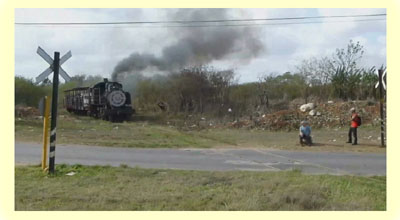About
Special News
Logan's Page
Jacoby's Page
Our Travel Index
Tracks Ahead Related Trips
Contact
Cuba - 2017
Cuba - A Revisit
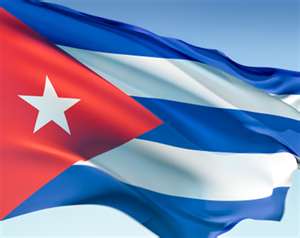 |
A revist for me, and a first for Barb, who wanted to see the country before it changed too much |
Readers Note:
The video files are of low resolution and are in AVI format. They must be downloaded and then played. I could have embedded them, but then you have to "Allow Blocked Content" and they play continuously, which I find dreadfully annoying. This way, if you want a video clip, download and play. Otherwise. skip it.
March 2
I was here seventeen years ago, on a similar Trains Unlimited Tour.
So I was most interested to see what has - and hasn't - changed.
Barb and I tapped into the trip with our Yakima, WA friends. Some
were missing, some were new, but it is a group of about 14 people.
We flew into Miami, where we all got together. Introductions were
made, and acquaintences were renewed. Our flight to Havana was
scheduled for the the afternoon, so eventually we all headed for the
gate. The flight to Havana was
delayed by about an hour, so we just cooled our heels.
Finally our plane arrived at Jose Marti International airport,
only to find that our guides had forgotten us.
This was not a good sign.
We managed to scare up someone from the Havanatur office, who provided a
ride to the Plaza Hotel. Once we
checked in – it looks the same, by the way – we went where all good
travelers to – to the bar. I
think we were loud and certainly made the waiter happy.
Dinner
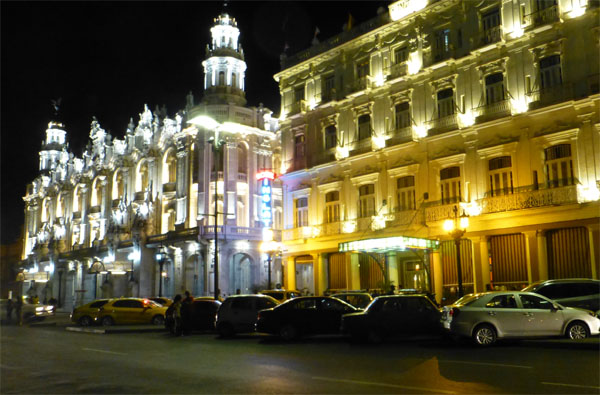 was the hotel buffet. We are all tired, but is not
too late to go exploring. We walked across the street to the lively
square, and had a nice view of the National Theater Building. It
was quite impressive. So did the only thing available, and
went to bed. Our room was very,
very noisy, as it was on the street side of the hotel.
Sleeping was impossible.
Again, not a good start to the trip.
was the hotel buffet. We are all tired, but is not
too late to go exploring. We walked across the street to the lively
square, and had a nice view of the National Theater Building. It
was quite impressive. So did the only thing available, and
went to bed. Our room was very,
very noisy, as it was on the street side of the hotel.
Sleeping was impossible.
Again, not a good start to the trip.
March 3
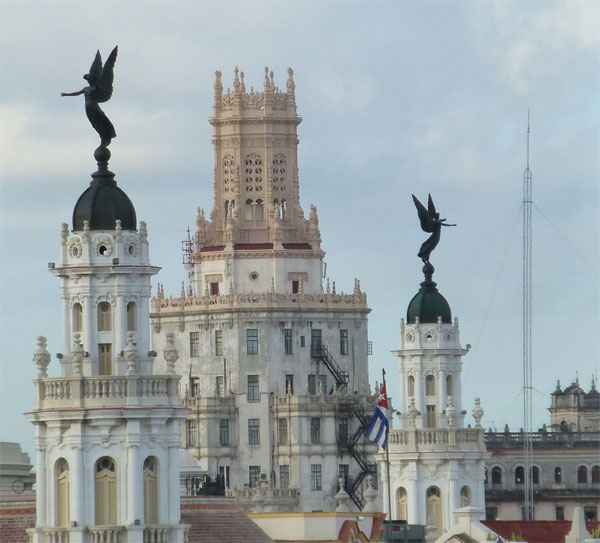 After a sleepless night due to the noise outside
the room, - I slept on the sofa in the sitting room - we went to
breakfast, and Barb got her first glimpse of the Havana skyline.
After a sleepless night due to the noise outside
the room, - I slept on the sofa in the sitting room - we went to
breakfast, and Barb got her first glimpse of the Havana skyline.
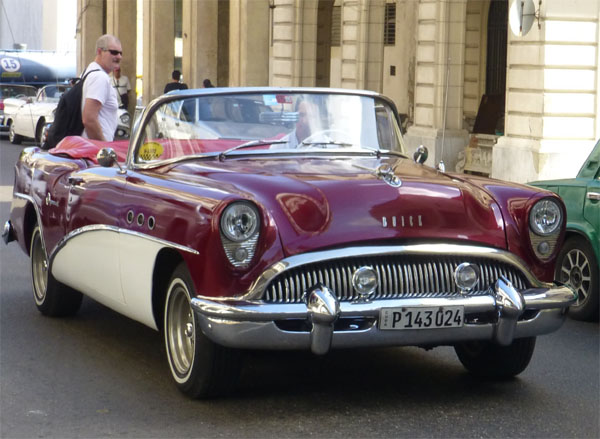
Of course, the initial thing that people
think about when you tell them you are visiting Cuba, is the old cars.
So that you are not diappointed, there is a prime example, although I
will post some additional photos and information at the end of this
missive.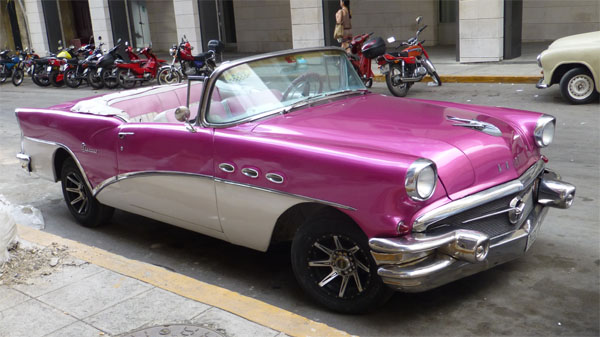
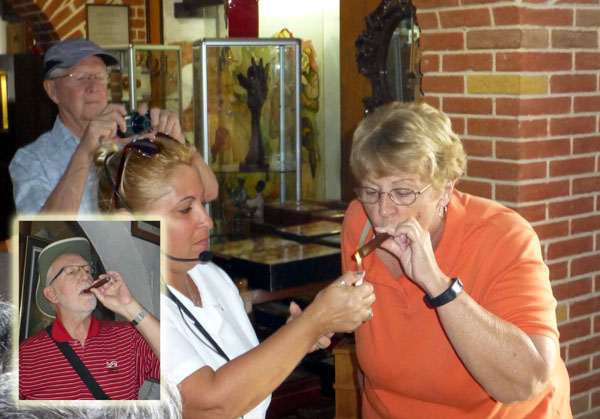
Breakfast was the usual hotel food mashup, and then it was on the tour bus for a trip to the La Partegas cigar factory. Been there, done that, but Barb got to smoke a fresh rolled cigar. And we bought a few cigars for people back at home.
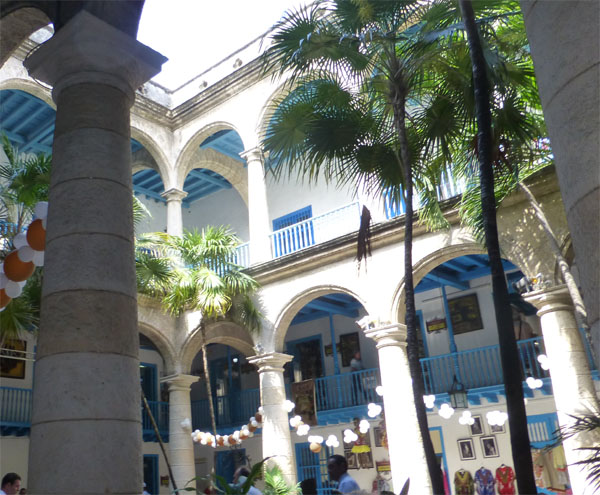 In the factory courtyard, we had coffee and rum, and
sat around for a bit, right away
finding our one take home picture, a sort of primitive of the Cuban
street.
Old cars abound. I
will talk more about these later, but you are constantly looking at the
old Detroit iron from the 1950's. It is said that this is a car
afficianado's dream, and that is so true. There are a ton of
tourists here, many
more than we had anticipated.
And the Plaza has not aged well.
Frankly, the country is not set up for this influx of tourists.
Bathrooms are broken, lines for money are extremely long, and
there is a great deal of demand.
In the factory courtyard, we had coffee and rum, and
sat around for a bit, right away
finding our one take home picture, a sort of primitive of the Cuban
street.
Old cars abound. I
will talk more about these later, but you are constantly looking at the
old Detroit iron from the 1950's. It is said that this is a car
afficianado's dream, and that is so true. There are a ton of
tourists here, many
more than we had anticipated.
And the Plaza has not aged well.
Frankly, the country is not set up for this influx of tourists.
Bathrooms are broken, lines for money are extremely long, and
there is a great deal of demand.
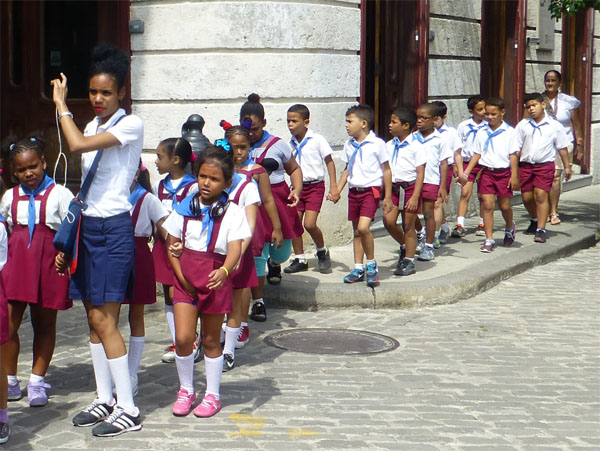
Note the school kids in uniforms. What a great idea. Primary schools are maroon, while the next level is tan, followed by blue in secondary school.
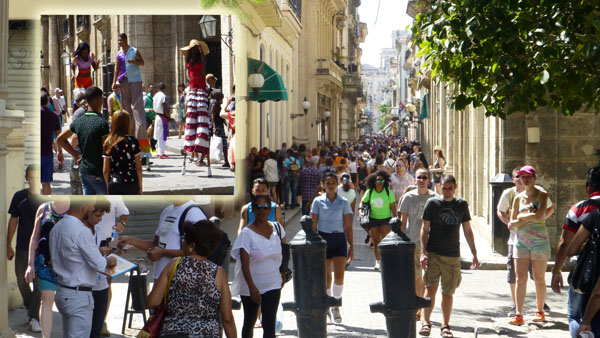 We wandered a
bit, fighting through the crowds, and located a restaurant for a brief
stop. We had a couple of snacks and just watched the street life,
which is lively and colorful.
We wandered a
bit, fighting through the crowds, and located a restaurant for a brief
stop. We had a couple of snacks and just watched the street life,
which is lively and colorful.
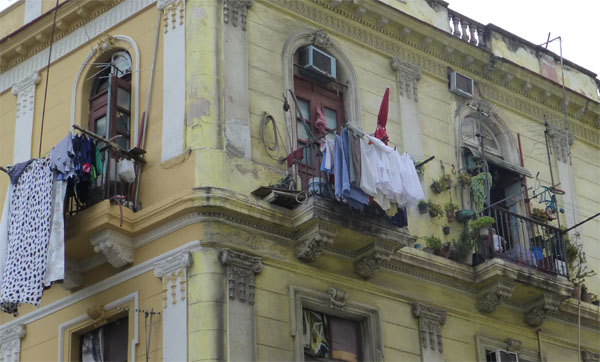
And everywhere you look are colorful buildings, restored frescos, and lots of laundry. Finally refreshed, we wandered back to the hotel, where we changed rooms, although to a double bed. This should be interesting. But the AC is cold, and the toilet got fixed, so we are off to a drink at La Floridita.
Dinner will be back at the hotel, as it is paid for. I am terrified of running out of cash. I remember what happened the last time. Not a pretty situation. OK, La Floridita was packed, and they were turning people away.
Besides, we were a party of eight people, so we
headed for another local watering
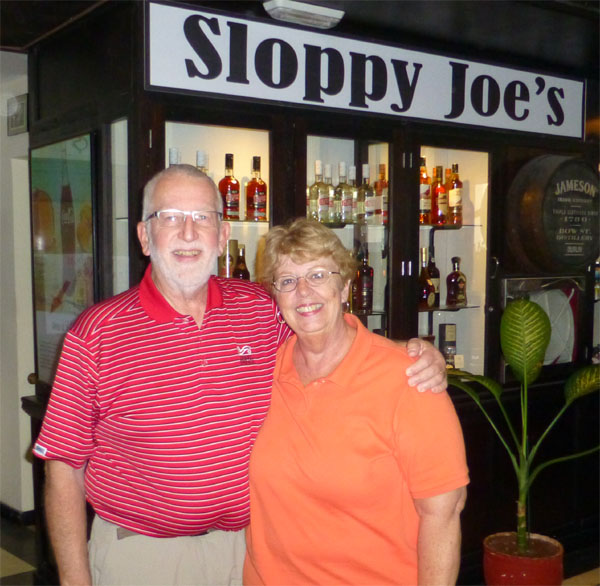 hole, Sloppy Joes.
It wasn’t crowded, and we pushed a couple of tables together and
had a really good time. They
had a shortened version of “Gone with the Wind” on a monitor, and we all
had a good time listening to John talk about his experiences working for
the Margaret Mitchell house in Atlanta.
So a lot of trivia was presented.
Dinner was back at the hotel, and we bailed out before the band
started.
hole, Sloppy Joes.
It wasn’t crowded, and we pushed a couple of tables together and
had a really good time. They
had a shortened version of “Gone with the Wind” on a monitor, and we all
had a good time listening to John talk about his experiences working for
the Margaret Mitchell house in Atlanta.
So a lot of trivia was presented.
Dinner was back at the hotel, and we bailed out before the band
started.
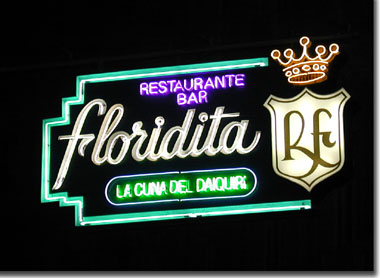 Barb and I walked
back over to La Floridita, and this time, we got in and had a daiquiri.
It was loud, noisy, and colorful, though rather touristy.
The all female combo was lively and spirited, and of course, selling
their CDs.
In addition to being a local watering hole for Ernst Hemingway –
a very big deal around here – the daiquiri drink was invented here.
It was crowded, had a nice combo, and we were the oldest people
there.
Barb and I walked
back over to La Floridita, and this time, we got in and had a daiquiri.
It was loud, noisy, and colorful, though rather touristy.
The all female combo was lively and spirited, and of course, selling
their CDs.
In addition to being a local watering hole for Ernst Hemingway –
a very big deal around here – the daiquiri drink was invented here.
It was crowded, had a nice combo, and we were the oldest people
there.
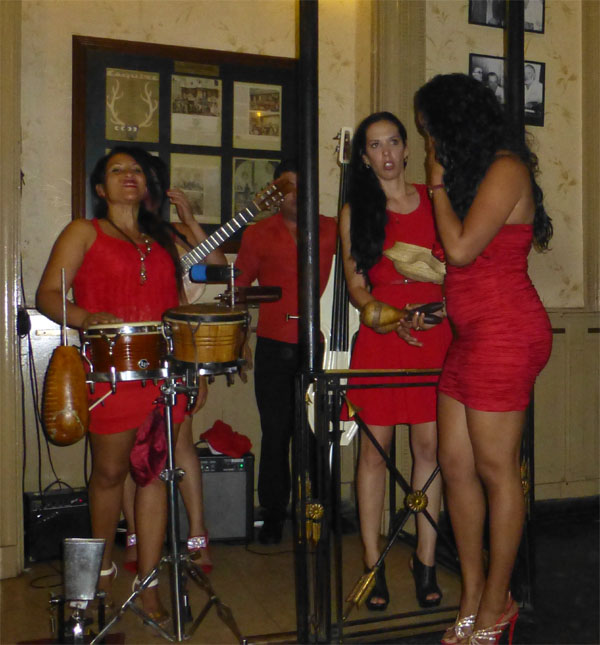
We each had one drink
(cash dispersal, remember?) and came back to the hotel.
While we now have a double bed, the AC has been turned down to
snow. So ends out first full
day in Cuba. It will be
interesting to see if the crowds are the same the further we get into
the island interior.
March 4
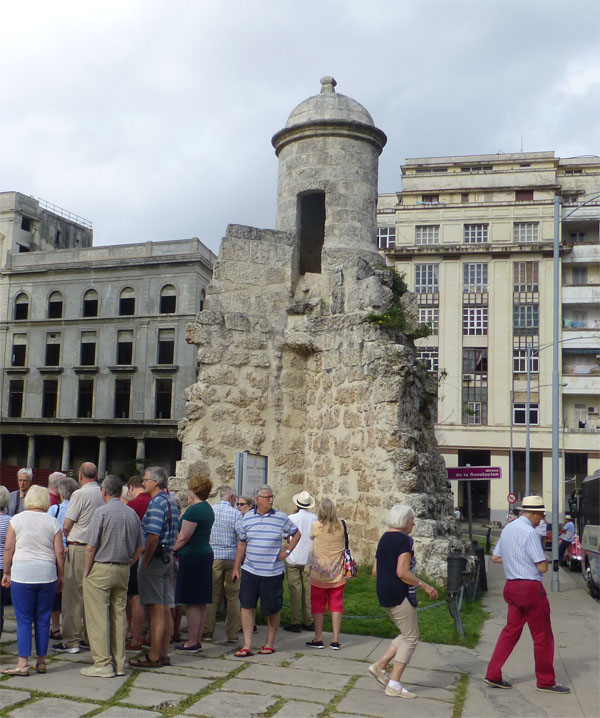 Our
first stop this morning was just outside the Museum of the Revolution.
These are the a portion of the original city walls of Havana. Note
the guard tower.
Our
first stop this morning was just outside the Museum of the Revolution.
These are the a portion of the original city walls of Havana. Note
the guard tower.
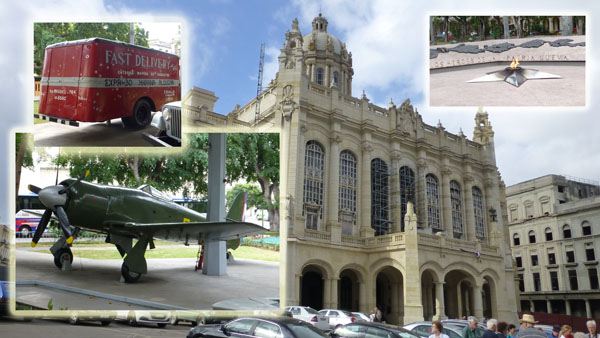 From
there, we just turned ourselves around for the Museum of the Revolution. We saw the war
planes and some of the artifacts that were essential in the revolution.
Note the bullet ridden delivery truck, and the Eternal Flame. The
Granma boat which brought Fidel and his accomplices back to the island
is also on display. The thing is in a glass enclosure, so photos
are practically impossible. Of course, we had to exit through the
gift shop. I'm pleased that Barb got
to see all of this.
From
there, we just turned ourselves around for the Museum of the Revolution. We saw the war
planes and some of the artifacts that were essential in the revolution.
Note the bullet ridden delivery truck, and the Eternal Flame. The
Granma boat which brought Fidel and his accomplices back to the island
is also on display. The thing is in a glass enclosure, so photos
are practically impossible. Of course, we had to exit through the
gift shop. I'm pleased that Barb got
to see all of this.
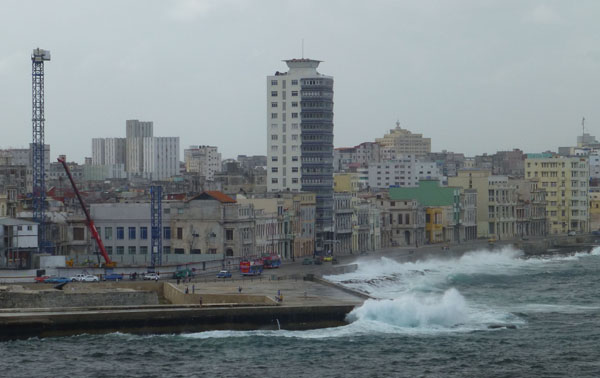 We
drove through a tunnel to the otherside of the Bay so that we could
climb a bit on the old walls of the City. You could look back on
the Havana skyline. It was a little chilly and rainy, which made
the waves kick up along the Malecon, which is the main highway along the
city waterfront.
We
drove through a tunnel to the otherside of the Bay so that we could
climb a bit on the old walls of the City. You could look back on
the Havana skyline. It was a little chilly and rainy, which made
the waves kick up along the Malecon, which is the main highway along the
city waterfront.
The next stop was the Plaza de la Revolution,
which is the main square for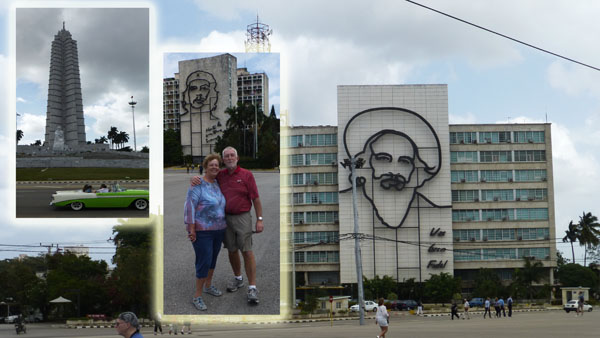 rallys. This is where the Pope met the Cuban people last year.
It is probably the most iconic square photographed, with the two faces
outlied on official buildings. The faces are Che Guevara, and
Camila Cienfuegos (oftern mistaken for Fidel). The verticle
monument is dedicated to Jose Marti.
rallys. This is where the Pope met the Cuban people last year.
It is probably the most iconic square photographed, with the two faces
outlied on official buildings. The faces are Che Guevara, and
Camila Cienfuegos (oftern mistaken for Fidel). The verticle
monument is dedicated to Jose Marti.
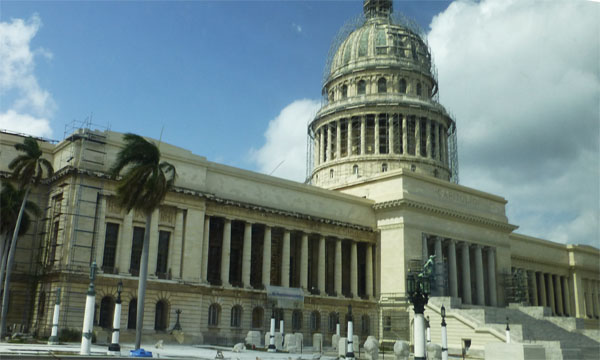 Then
it was back into town. This is the Capitol Building. Does it
look familiar? It should, as it is modeled afte the US Capitol,
complete with columns, dome and wings. And like the US version,
under renovation. The rest of the city has colorful buildings,
which must have been dazzling in the 1950's Time and humdity have
taken their toll on many of them.
Then
it was back into town. This is the Capitol Building. Does it
look familiar? It should, as it is modeled afte the US Capitol,
complete with columns, dome and wings. And like the US version,
under renovation. The rest of the city has colorful buildings,
which must have been dazzling in the 1950's Time and humdity have
taken their toll on many of them.
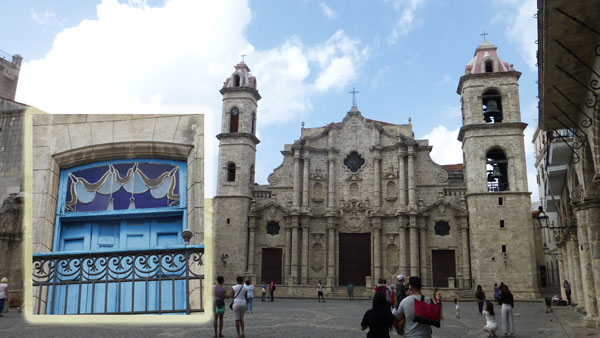 We had another
long lunch at some restaurant in the interior courtyard of the Casa del
Marquis de Arcos. It was well maintained and had some nicely
restored stained glass.
We had another
long lunch at some restaurant in the interior courtyard of the Casa del
Marquis de Arcos. It was well maintained and had some nicely
restored stained glass.
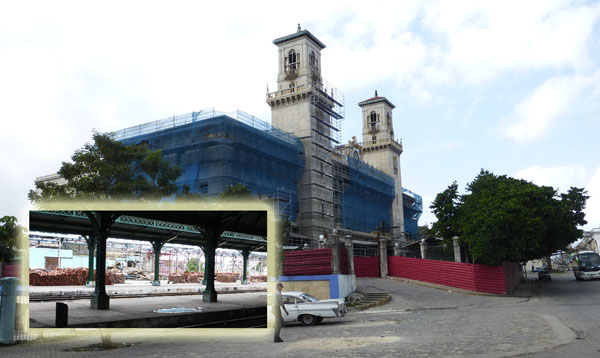 Now
we were off to the main train station, which is closed, as they are
renovating it. So there were
empty yards and a lot of debris.. When
I was here before, it was a bustling operation. Perhapos it will
again be, but for the moment, it was just deserted.
Now
we were off to the main train station, which is closed, as they are
renovating it. So there were
empty yards and a lot of debris.. When
I was here before, it was a bustling operation. Perhapos it will
again be, but for the moment, it was just deserted.
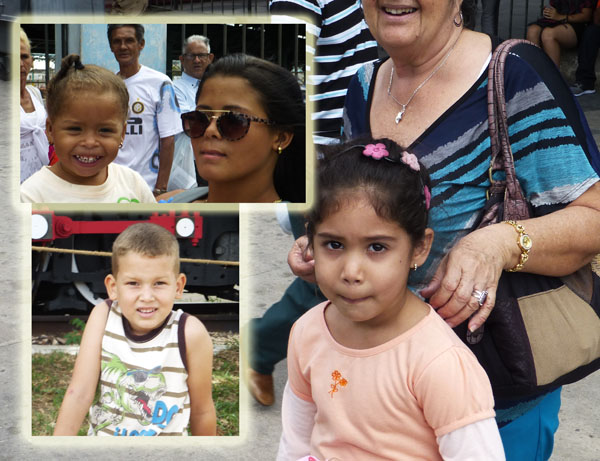
Instead of waiting around for trains, people were waiting for the bus.
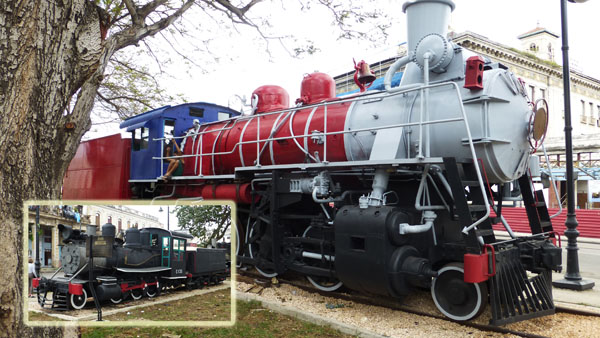
We had a short lecture about a government sponsored restoration project for steam locos, and saw the empty shell of what was to be a museum. There were the usual static displays.
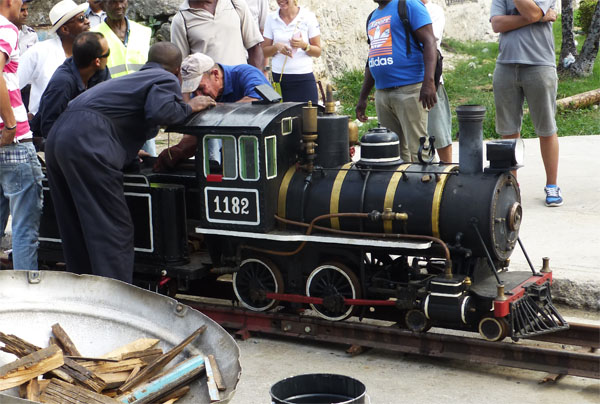 However
the rail group did run a
rebuilt 15 inch gauge Vulcan (Cagney) amusement park loco.
This was a pretty big deal because it drew a large crowd and our tour
guides were taking photos too.
However
the rail group did run a
rebuilt 15 inch gauge Vulcan (Cagney) amusement park loco.
This was a pretty big deal because it drew a large crowd and our tour
guides were taking photos too.
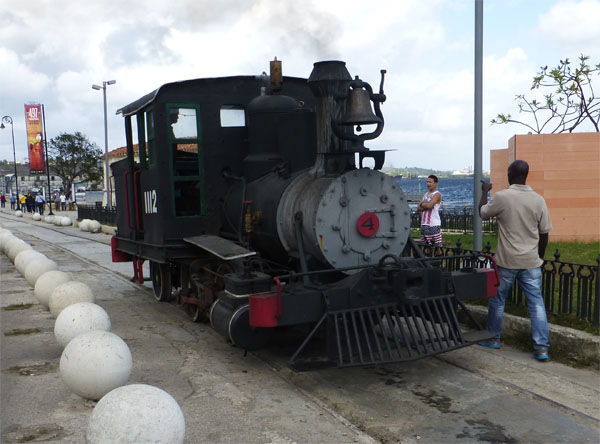 Then it was on to another museum restoration project which was a
loco that had once run along the docks.
Then it was on to another museum restoration project which was a
loco that had once run along the docks.
The main draw was a brew pub – yes, these establishments have made their way to Havana.
Back the hotel. Went next
door to the roof of the neighboring hotel for a drink.
A MUCH nicer place than this.
Wow. The Plaza may
have been good 20 years ago, b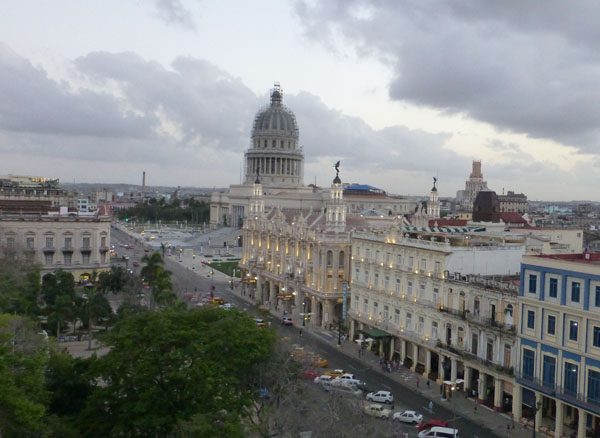 ut has been eclipsed by better places.
ut has been eclipsed by better places.
Back to Sloppy Joes for an original, and fabulous, sloppy joe.
What else? We are all
tired. Tomorrow we start the
trek down the island. We all
hope the hotels get better.
Our hot water no longer works.
I have been deemed “the toilet whisperer” because I can make the
thing work. Sigh.
March 5
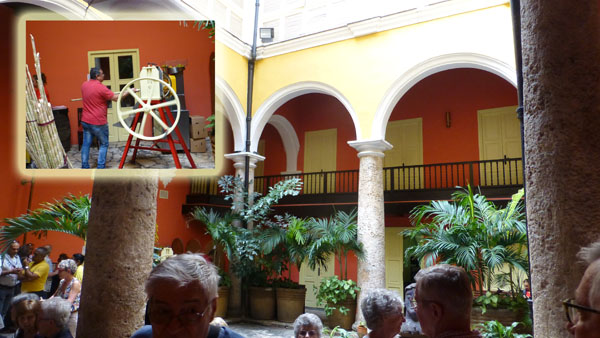 We
started today with a visit to the Havana Club Rum Museum.
As usual, there was a lot of waiting around.
John tried to clarify things on behalf of the guide (Angelina),
and later got yelled at for not letting her do her job.
Maybe, if she could communicate better, and was better organized,
she might not have people trying to help her.
We
started today with a visit to the Havana Club Rum Museum.
As usual, there was a lot of waiting around.
John tried to clarify things on behalf of the guide (Angelina),
and later got yelled at for not letting her do her job.
Maybe, if she could communicate better, and was better organized,
she might not have people trying to help her.
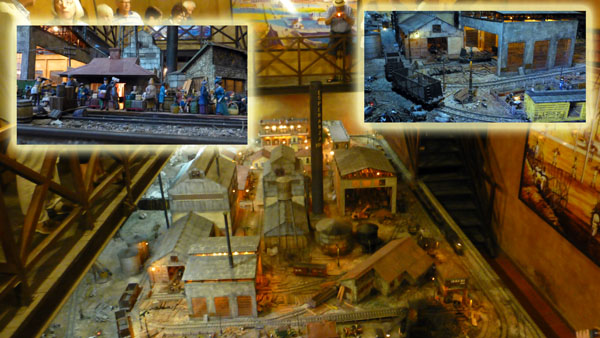 The
rum museum was the usual gig, but did have two pluses:
first, we got to taste some of the seven year old Havana Club,
and they had an O gauge model railroad that showed the rum making,
from cane and slaves, the crushing and the mills and refining.
It was pretty neat.
The
rum museum was the usual gig, but did have two pluses:
first, we got to taste some of the seven year old Havana Club,
and they had an O gauge model railroad that showed the rum making,
from cane and slaves, the crushing and the mills and refining.
It was pretty neat.
Today, we leave Havana and start to make our way down to the end of the island. So the railroad potion of the adventure begins.
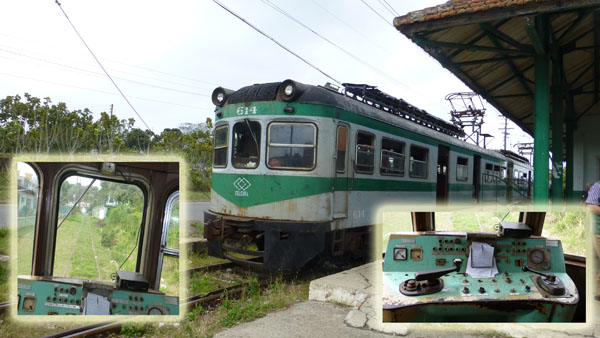 The
first event was a visit to the Hershey Trolleys, which as it turns out,
are still a public run. It was
originally built by the Hershey Chocolate company when they had a plant
in Cuba. The
train does not go to the end station in Casa Blanca, and frankly,
looking at the rails, it hasn’t gone there or some time.
But we boarded in the rain, and eventually, after much waiting,
headed down the line to Mantanzas.
The Hershey stop is half way.
Along the way are the usual green tunnel, but stations that were
just concrete shelters in the seeming middle of nowhere.
People would get off, and just disappear into the tangle of
brush. The rails aren’t in
the best of repair, and watching the front car hop around, did tend to
make one nervous. Things are
a little loose on the time schedule, as one passenger had to find a
toilet. So they just stopped
the train and off he went into the woods.
Okay then.
The
first event was a visit to the Hershey Trolleys, which as it turns out,
are still a public run. It was
originally built by the Hershey Chocolate company when they had a plant
in Cuba. The
train does not go to the end station in Casa Blanca, and frankly,
looking at the rails, it hasn’t gone there or some time.
But we boarded in the rain, and eventually, after much waiting,
headed down the line to Mantanzas.
The Hershey stop is half way.
Along the way are the usual green tunnel, but stations that were
just concrete shelters in the seeming middle of nowhere.
People would get off, and just disappear into the tangle of
brush. The rails aren’t in
the best of repair, and watching the front car hop around, did tend to
make one nervous. Things are
a little loose on the time schedule, as one passenger had to find a
toilet. So they just stopped
the train and off he went into the woods.
Okay then.
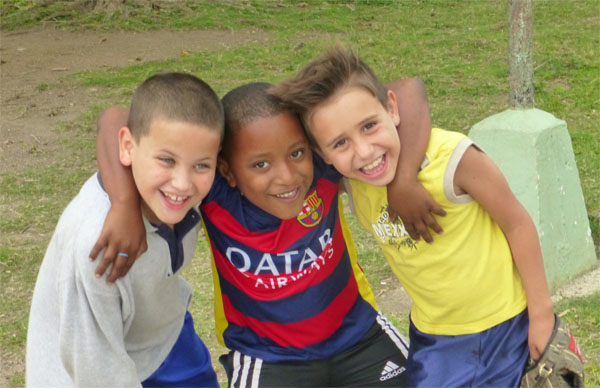 We
wound up in Matanzas an hour ahead of the bus, that was on a run to
Hemingway’s house, which turned out to be closed, and no amount of
“mordita” could get it open.
We
wound up in Matanzas an hour ahead of the bus, that was on a run to
Hemingway’s house, which turned out to be closed, and no amount of
“mordita” could get it open.
The town was deadsville, except for some really cute kids hanging out.
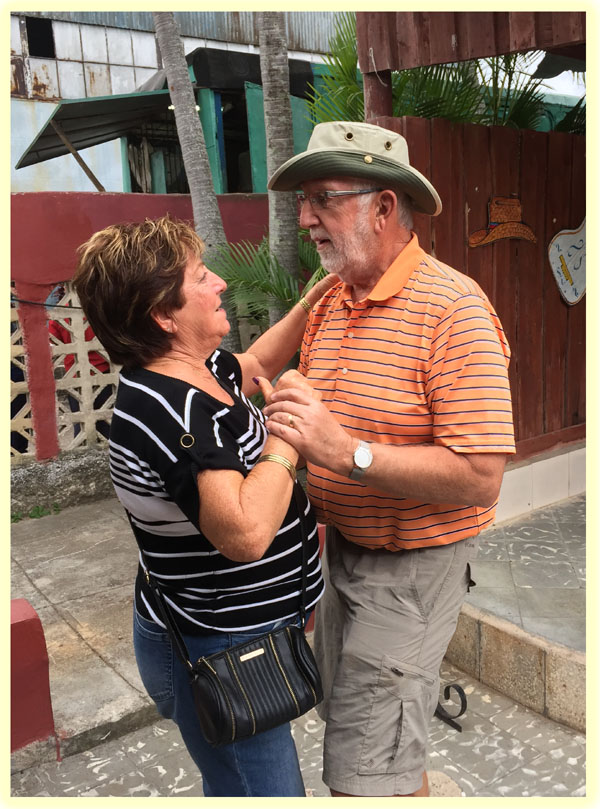 So for those of us waiting, we ended up in a bar, and I ended up dancing
with a local woman, who kept trying to talk to me.
I could not understand a word of what she was saying.
Ah, beer is a wonderful thing.
We had a few laughs.
So for those of us waiting, we ended up in a bar, and I ended up dancing
with a local woman, who kept trying to talk to me.
I could not understand a word of what she was saying.
Ah, beer is a wonderful thing.
We had a few laughs.
The bus finally arrived, and we ended up at an all- inclusive resort on Veradero. We arrived at 6, and we have to leave by 6:45 tomorrow. It only goes to prove that the shorter the stay, the nicer the hotel. Here, the toilets flush and the water is at lease warm. We had drinks and dinner with John and Noel at an obscene buffet. Most of the world is starving, and we are turning down things. Unreal. Yea! Me thinks it will be noisy though, as with free alcohol, people are really getting hammered. Steam trains tomorrow.
March 6
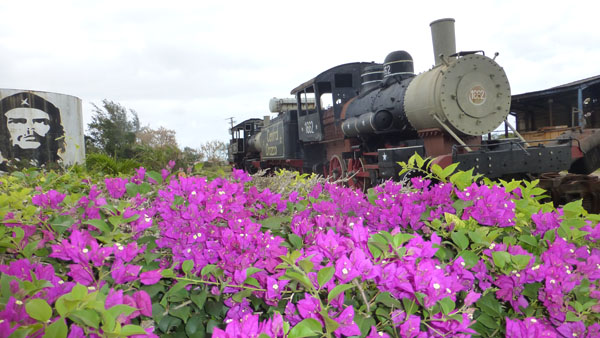 Here
are a few basic facts about Cuba.
The island is around 800 miles long, and averages 62 miles
across. The population is
just over 11 million, with the two largest cities being Havana and
Santiago (populations 2 million and just under a half million).
We had an early start, with bags on the bus at 0645.
We were off to the Jose Comas Sugar Mill.
Here
are a few basic facts about Cuba.
The island is around 800 miles long, and averages 62 miles
across. The population is
just over 11 million, with the two largest cities being Havana and
Santiago (populations 2 million and just under a half million).
We had an early start, with bags on the bus at 0645.
We were off to the Jose Comas Sugar Mill.
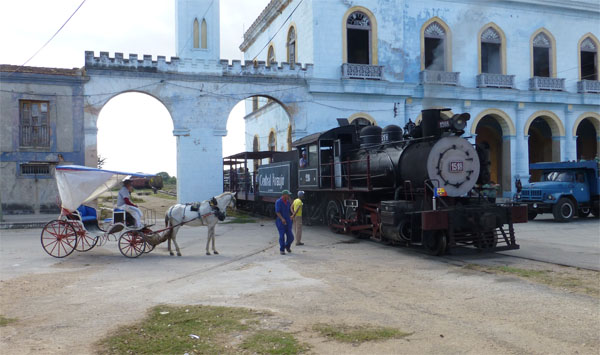 This
was an operating sugar mill, with lots of steam when I was here before.
Now it is a tourist train, and a railway and sugar museum.
So there are lots of static displays, with one or two operating
steamers. We did some runbys
which was on an out and back line, which took about an hour.
This
was an operating sugar mill, with lots of steam when I was here before.
Now it is a tourist train, and a railway and sugar museum.
So there are lots of static displays, with one or two operating
steamers. We did some runbys
which was on an out and back line, which took about an hour.
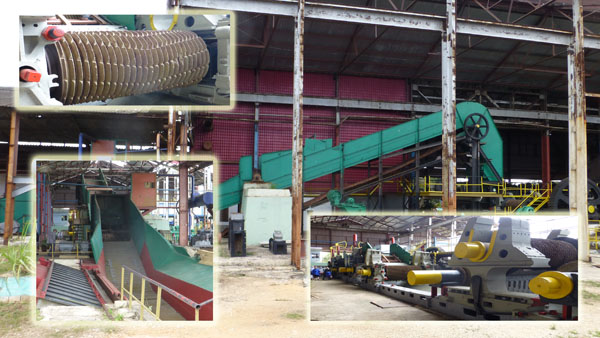 The
thing that impressed me about the sugar mill was the size of the
equipment. We are talking BIG machinery here: big chopping
wheels, big gears, big belts and rollers. Most of the this stuff
was made in the USA. The sudden drop in the price of sugar put
most of these places out of business. There is still sugar
processing on the island, but the smaller mills appear to be gone.
We will visit one mill that uses rail to haul the cane, but it is a
diesel operation. Due to the huge backshop overhead, the days of
steam are gone.
The
thing that impressed me about the sugar mill was the size of the
equipment. We are talking BIG machinery here: big chopping
wheels, big gears, big belts and rollers. Most of the this stuff
was made in the USA. The sudden drop in the price of sugar put
most of these places out of business. There is still sugar
processing on the island, but the smaller mills appear to be gone.
We will visit one mill that uses rail to haul the cane, but it is a
diesel operation. Due to the huge backshop overhead, the days of
steam are gone.
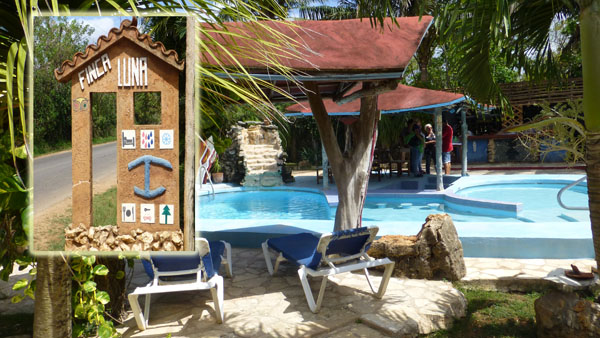 Lunch
turned out to be at a pretty nice place called Finca Luna, again with
the Noon music combo.
Couldn’t we have one meal with no band?
As usual, one liquid included.
This place was well rated by Trip Advisor.
There were things to buy, and a
small animal display.
Lunch
turned out to be at a pretty nice place called Finca Luna, again with
the Noon music combo.
Couldn’t we have one meal with no band?
As usual, one liquid included.
This place was well rated by Trip Advisor.
There were things to buy, and a
small animal display.
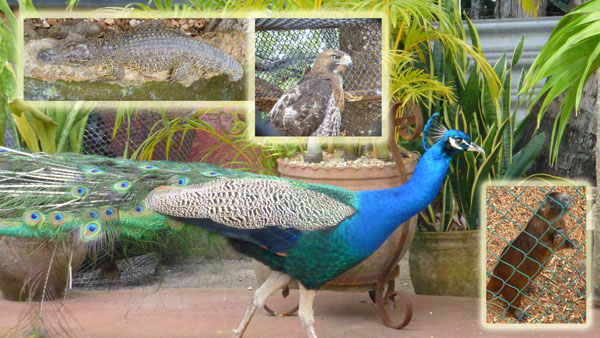 It was really a pretty nice place; off the beaten track with good
food and amenities. One of
our group is ill. We all
feel pretty bad for him, as it could be any of us.
It was really a pretty nice place; off the beaten track with good
food and amenities. One of
our group is ill. We all
feel pretty bad for him, as it could be any of us.
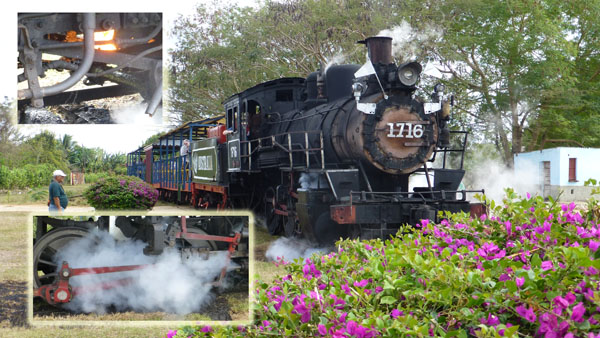 After lunch we hit another steam tourist line.
Too bad these are all relegated to tourist excursions.
We had more runbys to satisfy the rail fans, followed by a long
bus ride to Santa Clara.
After lunch we hit another steam tourist line.
Too bad these are all relegated to tourist excursions.
We had more runbys to satisfy the rail fans, followed by a long
bus ride to Santa Clara.

Note the bananas growing on a tree. These are a little smaller than the ones we see in the grocery stores, but are sweeter. They grow up, and have this weird bulb thing hanging down below the bunch.
.
 A
whole banana plantation looks like this. Trees grow over a nine to
sixteen month period, and you get one bunch of crop per tree.
The banana tree is not really a "tree" but a cluster of tightly woven
stems that grow from a bulb. According to the web, once the tree
flowers and bears fruit, it is done. Propagation is done by
planting bulb "pups" think shoots - from the original bulb
A
whole banana plantation looks like this. Trees grow over a nine to
sixteen month period, and you get one bunch of crop per tree.
The banana tree is not really a "tree" but a cluster of tightly woven
stems that grow from a bulb. According to the web, once the tree
flowers and bears fruit, it is done. Propagation is done by
planting bulb "pups" think shoots - from the original bulb
Our guide, Angelina, said that this hotel, the
Santa Clara Hotel, was the worst of the lot.
Au Contrere! While
the rooms are tiny,
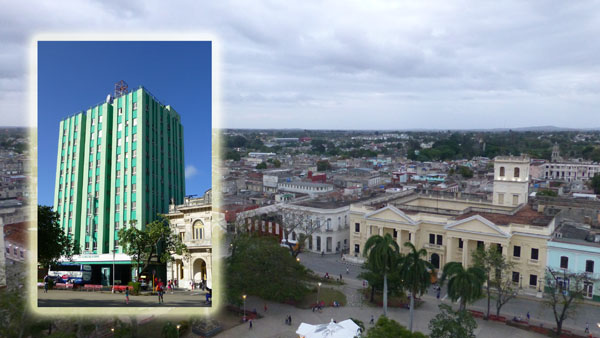 we
ALL have working toilets, good water pressure, and hot water.
What’s not to like. I
think this place was an ex-soviet operation, but has been kept up to
some extent. As a bit of
foreshadowing, there would be a worse place yet to come.
It has been chilly, and I had to grab a jacket.
We retired to – where else – the rooftop bar, which offered nice
views of the city. It was windy
and chilly, but we managed.
The usual buffet dinner was passable.
The Cuban food is generally pretty bland, consisting mostly of
chicken, pork, fish, rice, beans, and fruit.
It’s healthy, but (if I recall) even in the paladars (private
home restaurants) , there isn’t much spice to things.
Of course, one liquid was included.
we
ALL have working toilets, good water pressure, and hot water.
What’s not to like. I
think this place was an ex-soviet operation, but has been kept up to
some extent. As a bit of
foreshadowing, there would be a worse place yet to come.
It has been chilly, and I had to grab a jacket.
We retired to – where else – the rooftop bar, which offered nice
views of the city. It was windy
and chilly, but we managed.
The usual buffet dinner was passable.
The Cuban food is generally pretty bland, consisting mostly of
chicken, pork, fish, rice, beans, and fruit.
It’s healthy, but (if I recall) even in the paladars (private
home restaurants) , there isn’t much spice to things.
Of course, one liquid was included.
After dinner, we walked around the square, which
was rather nice. John and
entourage went into a fine arts museum that had a great collection.
He was really impressed and made a new buddy.
Tomorrow we have a slightly later start, which is welcomed by
all.
March 7
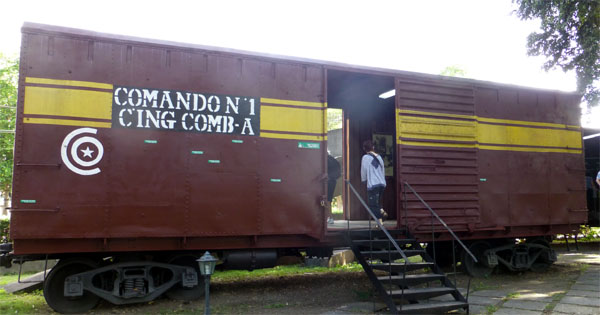 Our
first stop on the way out of town was to the "armored train." This
was a collection of boxcars and assorted earth moving quipment which was
used during the revolution.
Our
first stop on the way out of town was to the "armored train." This
was a collection of boxcars and assorted earth moving quipment which was
used during the revolution.
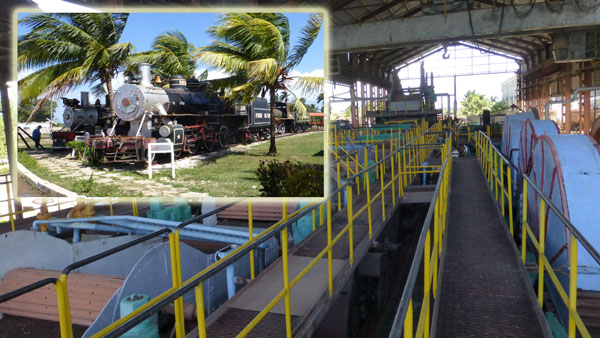
Once settled on the bus, we were off to a steam museum, a sugar mill museum, and a steam tourist train. Again, look at the size of this stuff. The rollers and crushing apparatus are very large.
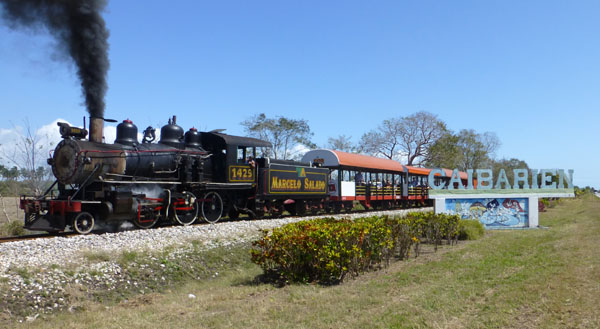 I
had the opportunity to talk to our two Cuban guides, Danielys (D) and
Danae (Danny.) about the current government administration.
Both think that Raul Castro is doing a good job, particularly in
instituting changes at a slow pace.
Both are positive about the future.
Fidel was loved by the people and had a great deal of charisma which is something that Raul
does not have. But he seems
to be an able administrator.
Both women thought that the general population feels that the country
wants to stay independent and not be taken over by Western corporations.
Education is free, but there is a post high school test that is
quite difficult. In regards
to the labor market, the government tries to project out ward for jobs,
and steers people to occupations to meet those projected needs.
Half of our group stayed in Remedios, where we treated to the
usual long lunch and looked at a church.
I
had the opportunity to talk to our two Cuban guides, Danielys (D) and
Danae (Danny.) about the current government administration.
Both think that Raul Castro is doing a good job, particularly in
instituting changes at a slow pace.
Both are positive about the future.
Fidel was loved by the people and had a great deal of charisma which is something that Raul
does not have. But he seems
to be an able administrator.
Both women thought that the general population feels that the country
wants to stay independent and not be taken over by Western corporations.
Education is free, but there is a post high school test that is
quite difficult. In regards
to the labor market, the government tries to project out ward for jobs,
and steers people to occupations to meet those projected needs.
Half of our group stayed in Remedios, where we treated to the
usual long lunch and looked at a church.
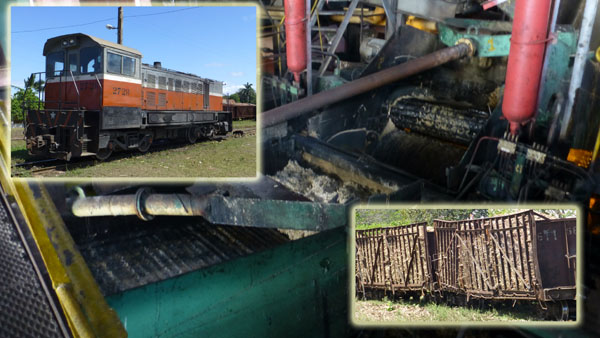 And
then we were off to yet another sugar mill, this time one which was in
operation. Only it wasn’t in
operation, it was down for maintenance.
The result was a bunch of tourists looking at a bunch of workers
who were looking at a bunch of tourists.
The railyard was closed as well, as we saw dead British diesels
and loaded cane cars.
And
then we were off to yet another sugar mill, this time one which was in
operation. Only it wasn’t in
operation, it was down for maintenance.
The result was a bunch of tourists looking at a bunch of workers
who were looking at a bunch of tourists.
The railyard was closed as well, as we saw dead British diesels
and loaded cane cars.
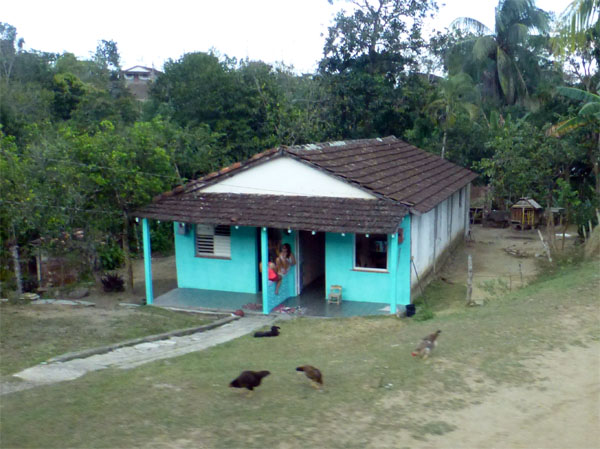 Then
it was back on the bus to Remedios, passing many of these standardized
houses along the way. Note that they all have TV and electricity.
They have a similar design: a shotgun hallway with a front room and
kitchen/dining area on the one side, and generally three bedrooms on the
other.
Then
it was back on the bus to Remedios, passing many of these standardized
houses along the way. Note that they all have TV and electricity.
They have a similar design: a shotgun hallway with a front room and
kitchen/dining area on the one side, and generally three bedrooms on the
other.
Our three hour bus ride culminated at an all inclusive resort in Trinidad.
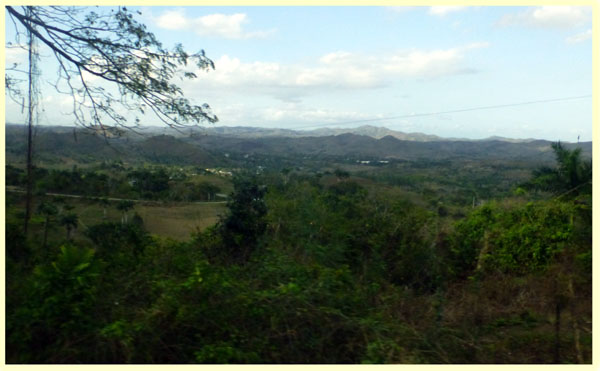
Although it was a long ride, we went across the island and over the mountains.
The scenery and
vistas were beautiful.
Rather than the drunk college kids on a cheap holiday, this place
had a family and older clientele.
The drinks were good, the dinner forgettable, and the post dinner
show rather fun. We have hot
water and toilet seats. Yea!
Fortunately, we are here for two nights.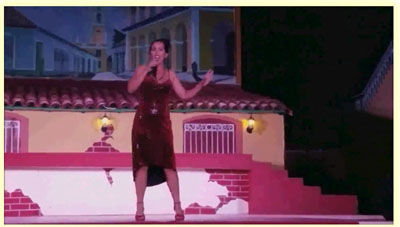
March 8
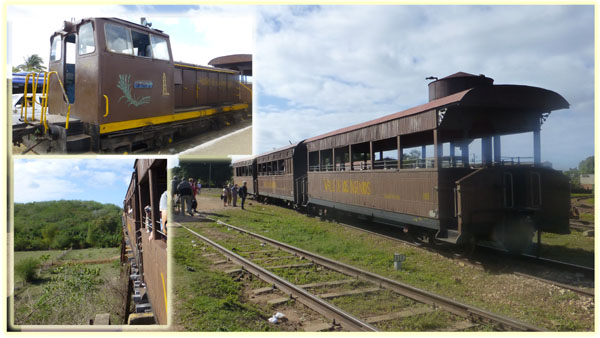 Breakfast
was the usual madhouse of mystery food.
We did get out on time and off to Trinidad, for the tourist train
ride. It was a three car
affair, pulled by what looked to be a Plymouth.
Breakfast
was the usual madhouse of mystery food.
We did get out on time and off to Trinidad, for the tourist train
ride. It was a three car
affair, pulled by what looked to be a Plymouth.
The scenery was interesting, but some schlub grabbed the very front corner, and proceeded to hang out the window the entire trip recording with his SLR. I wonder if anyone will ever look at the footage? So most of my stills were taken either looking straight out, or looking to the rear. The line did have a really nice trestle, and that would have made for a great shot from the ground. I have to quit thinking like a producer.
Our destination
was Iznaga, which is know for a rather tall tower. The story goes
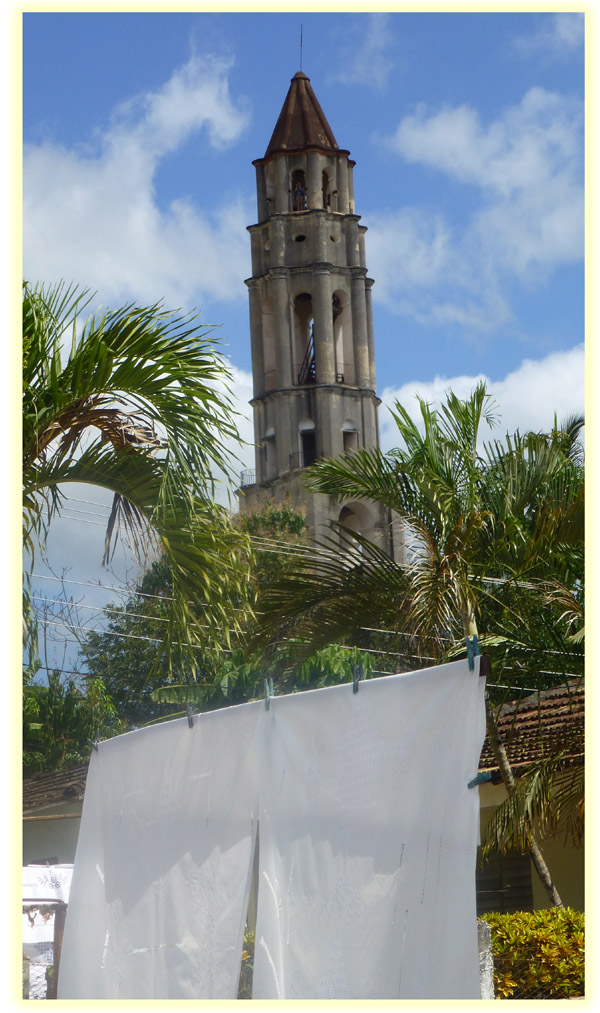 that
this was built by the two sons of a wealthy sugar plantation
owner. It seems that the one
to build the tower would win the hand of fair maiden in the household.
The tower was built, but the owner married the girl himself.
The other version just has the owner building the thing so he
could keep watch over the plantation slaves.
You decide.
that
this was built by the two sons of a wealthy sugar plantation
owner. It seems that the one
to build the tower would win the hand of fair maiden in the household.
The tower was built, but the owner married the girl himself.
The other version just has the owner building the thing so he
could keep watch over the plantation slaves.
You decide.
At any rate, we departed the train at Iznaga, opting NOT to ride to the end of the line. Instead we helped the local craft economy.
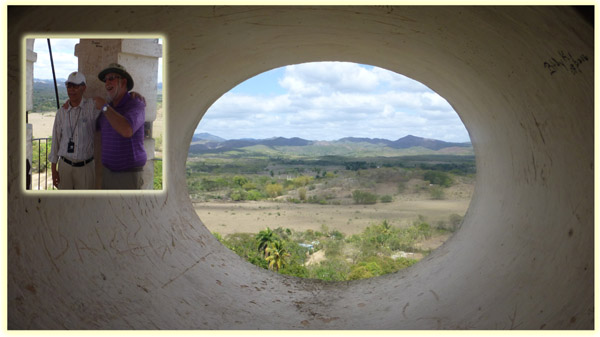 John,
Noel and I climbed to the top of the tower, which was rather scary, with
narrow, steep stairs. The
end result was impressive views of the countryside.
I had a rather defining moment at the top of the tower.
While admiring the view, and trying not to get queasy looking
over the edge, I was approached by a Japanese tourist.
You may (or may not) know that the Japanese and Chinese aften
want their photo taken with us Westerners.
The gentleman asked if he could have a photo with “grandpa.”
Really? That hurt.
John,
Noel and I climbed to the top of the tower, which was rather scary, with
narrow, steep stairs. The
end result was impressive views of the countryside.
I had a rather defining moment at the top of the tower.
While admiring the view, and trying not to get queasy looking
over the edge, I was approached by a Japanese tourist.
You may (or may not) know that the Japanese and Chinese aften
want their photo taken with us Westerners.
The gentleman asked if he could have a photo with “grandpa.”
Really? That hurt.
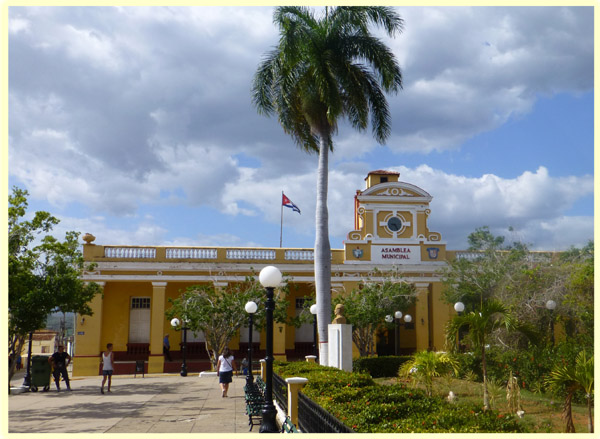 After
making our way down the steep, steep stairs, we caught our breath and
relaxed at the restaurant, which was the former plantation main house.
Lunch was the usual leisurely affair of fairly decent pulled pork, and
some other weird stuff,.
Gotta tell you. The food is
generally pretty bland. Then
all back on the bus to Trinidad.
After
making our way down the steep, steep stairs, we caught our breath and
relaxed at the restaurant, which was the former plantation main house.
Lunch was the usual leisurely affair of fairly decent pulled pork, and
some other weird stuff,.
Gotta tell you. The food is
generally pretty bland. Then
all back on the bus to Trinidad.
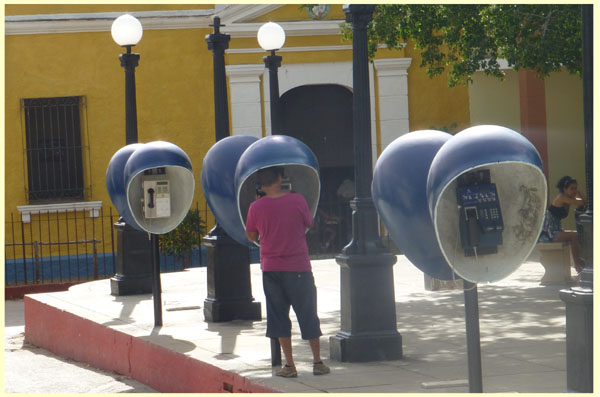 The
town square with all the multicolored buildings was pretty neat, as were
all then old cars. Barb and
I opted to people watch and wander the town on our own rather than go with the guided tour.
I can’t hear these things, and frankly, I don’t really care.
I know the people want to show off things, but I have not much
interest. I guess that makes
me shallow. I sometimes
think I’m to old to care. While
practically everyone has a mobile phone, there are still throwbacks to
an earlier time.
The
town square with all the multicolored buildings was pretty neat, as were
all then old cars. Barb and
I opted to people watch and wander the town on our own rather than go with the guided tour.
I can’t hear these things, and frankly, I don’t really care.
I know the people want to show off things, but I have not much
interest. I guess that makes
me shallow. I sometimes
think I’m to old to care. While
practically everyone has a mobile phone, there are still throwbacks to
an earlier time.
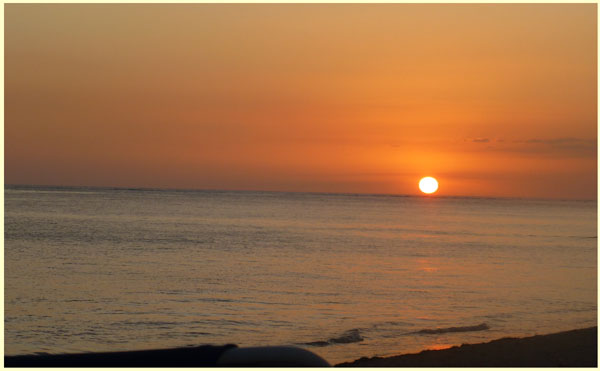 Then
it was back to the hotel where we were treated to a gorgeous sunset over
the Caribbean from a Cuban shore.
That was kind of cool.
A couple of mojitos may have helped that along.
We had intented to watch the show again, but Barb and I were
falling asleep, and the program was twenty minutes late in starting.
So we hiked back to our room, where we watched the moon and
stars, felt the breeze blowing off the mountains, and thought about how
far we have all come in life.
Then
it was back to the hotel where we were treated to a gorgeous sunset over
the Caribbean from a Cuban shore.
That was kind of cool.
A couple of mojitos may have helped that along.
We had intented to watch the show again, but Barb and I were
falling asleep, and the program was twenty minutes late in starting.
So we hiked back to our room, where we watched the moon and
stars, felt the breeze blowing off the mountains, and thought about how
far we have all come in life.
March 9
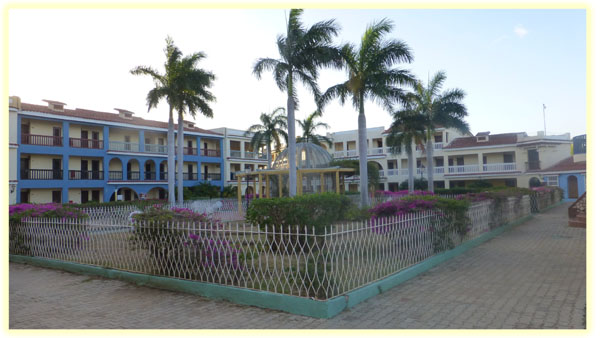 It
was a lovely morning on the southern coast of Cuba.
The resort was quiet and peaceful. But we had to leave, so
off we went to Sancti Spiritus, which is the capitol of the province
with the same name.
It
was a lovely morning on the southern coast of Cuba.
The resort was quiet and peaceful. But we had to leave, so
off we went to Sancti Spiritus, which is the capitol of the province
with the same name.
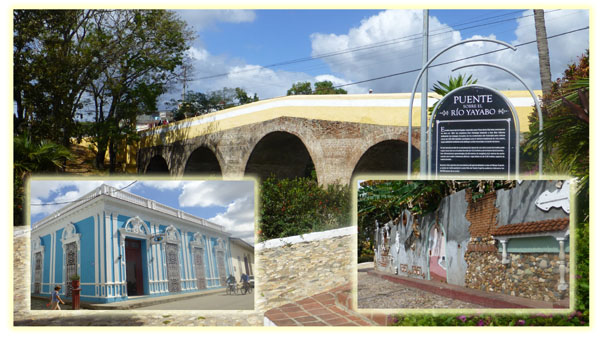 It was a
charming town, prosperous, with a pretty nifty bridge that appeared to
be its claim to fame. We
learned a little bit more about Cuban life.
People can freely own and sell property and move freely from city
to city.
You may have a business, but only one. For example, you can own a
restaurant, but not multiples.
I don’t know if that extends to single ownership of different
entities, but would suspect that you would not be able to do so.
One of our
It was a
charming town, prosperous, with a pretty nifty bridge that appeared to
be its claim to fame. We
learned a little bit more about Cuban life.
People can freely own and sell property and move freely from city
to city.
You may have a business, but only one. For example, you can own a
restaurant, but not multiples.
I don’t know if that extends to single ownership of different
entities, but would suspect that you would not be able to do so.
One of our
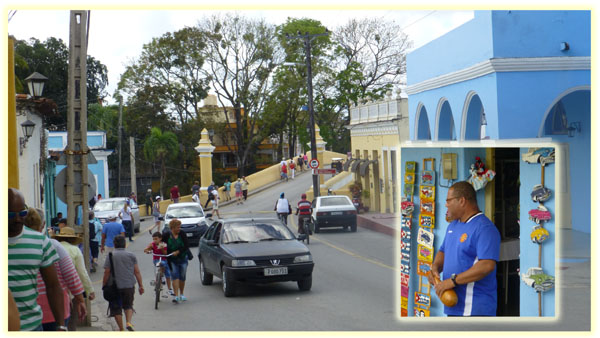 guides does own an apartment around Havana.
It has three bedrooms, kitchen bath, dining, living and a
terrace. The price was
$10,000. As I have not
measure to use for property valuation, I can’t make a judgement.
But that seems like a good deal.
guides does own an apartment around Havana.
It has three bedrooms, kitchen bath, dining, living and a
terrace. The price was
$10,000. As I have not
measure to use for property valuation, I can’t make a judgement.
But that seems like a good deal.
Most professional people work other jobs, with
tour guiding being a very lucrative way to earn extra money.
People do get housing, and a food ration which takes care of
about 45% of their monthly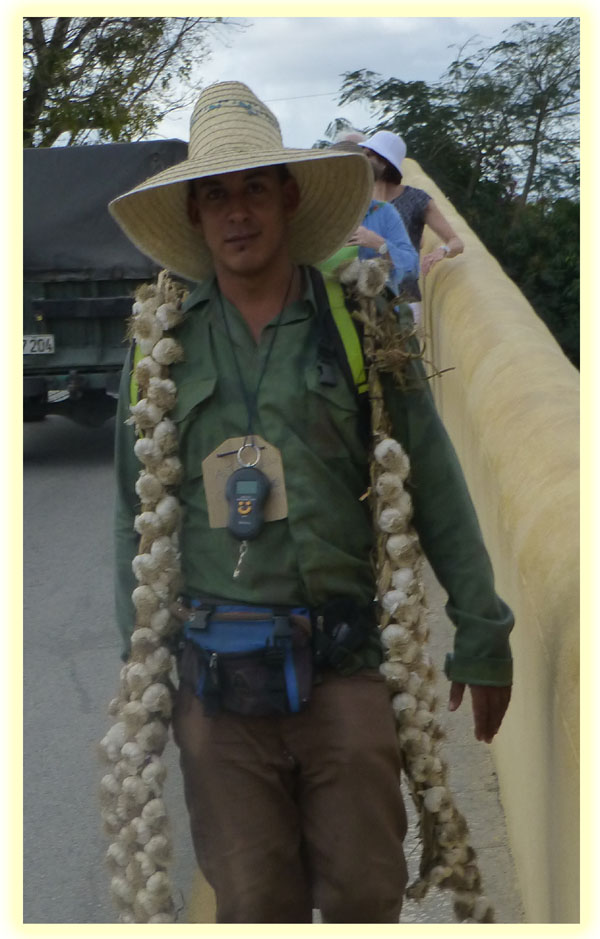 nutritional needs.
The official salary of everyone in Cuba is $25.
nutritional needs.
The official salary of everyone in Cuba is $25.
I heard varying reports on income levels, but some research shows the following general levels: 27% = $50/mo, 34% = $50-$100/mo, 20% = $101-200/mo, 12% = $201-500/mo, and 5% = $500+/mo. Education is free, as stated, as is health care. Our ill friend, had (I think) a two night stay in the hospital in Havana, which cost him a whopping $478. I'm certain our onion seller pictured here is not in the top echelon of incomes.
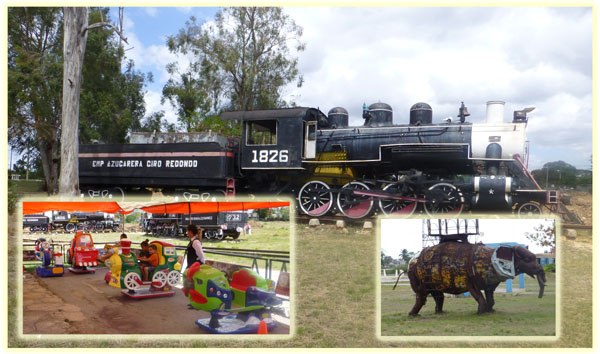 Lunch was in Ciela de Avila, and was not the
usual dragged out affair, but very fast and very good chicken.
Although we were seated next to a small children’s amusement
area. The airplane music got
old pretty quickly! There
were some old engines and yard art.
Note that the elephant is comprised of old auto parts and a cement mixer
as the body. The "ears" are car doors. Clever.
Lunch was in Ciela de Avila, and was not the
usual dragged out affair, but very fast and very good chicken.
Although we were seated next to a small children’s amusement
area. The airplane music got
old pretty quickly! There
were some old engines and yard art.
Note that the elephant is comprised of old auto parts and a cement mixer
as the body. The "ears" are car doors. Clever.
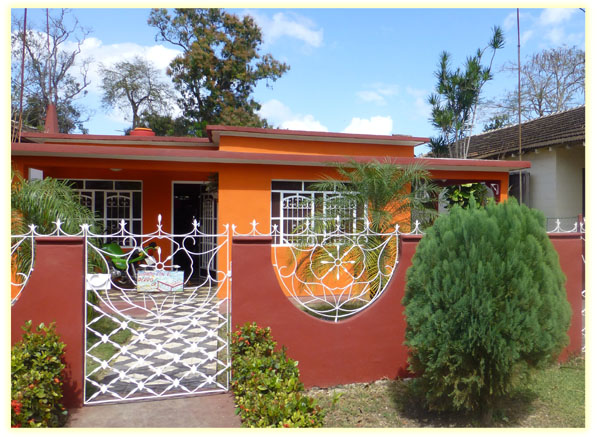 Note
this really nice looking house. It was out side of yet another sugar mill we
are to visit! I would have loved to get a look inside, to see if
it was a nice on the interior.
Note
this really nice looking house. It was out side of yet another sugar mill we
are to visit! I would have loved to get a look inside, to see if
it was a nice on the interior.
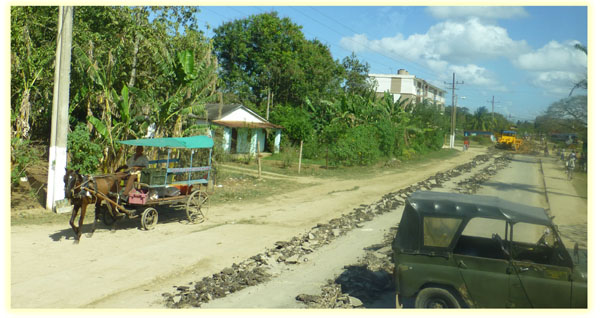 We
were somewhat stymied as we approached the sugar mill. The road
was torn up, and Raul, our driver, was forced to take several back
streets to our destination. But he made it. Judging by the
curious looks we got from some of the people, those streets never were
visited by a tour bus!
We
were somewhat stymied as we approached the sugar mill. The road
was torn up, and Raul, our driver, was forced to take several back
streets to our destination. But he made it. Judging by the
curious looks we got from some of the people, those streets never were
visited by a tour bus!
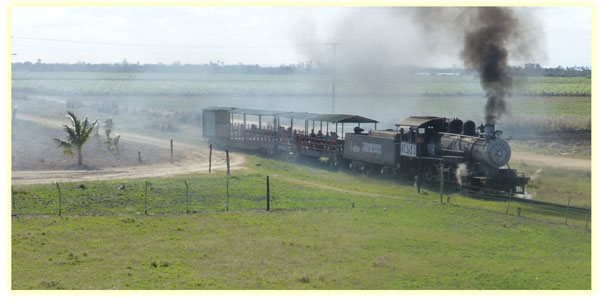 The rest of the afternoon was taken up with another tourist
train, at a now defunct sugar mill.
Unfortunately, the sun was behind us.
The rest of the afternoon was taken up with another tourist
train, at a now defunct sugar mill.
Unfortunately, the sun was behind us.
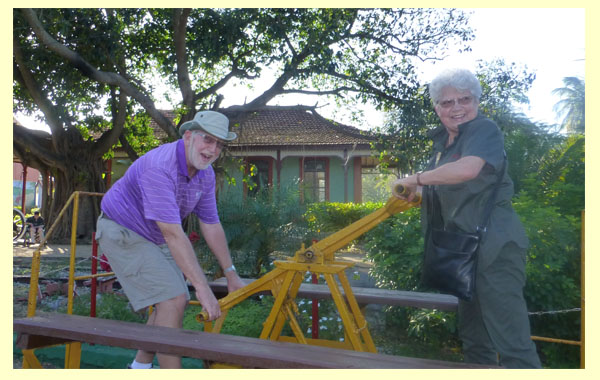 We did get an opportunity to try one of the old handcars. One of
our new British friends (Yvonne) and I had a go at making this work.
It was more difficult than you would imagine.
We did get an opportunity to try one of the old handcars. One of
our new British friends (Yvonne) and I had a go at making this work.
It was more difficult than you would imagine.
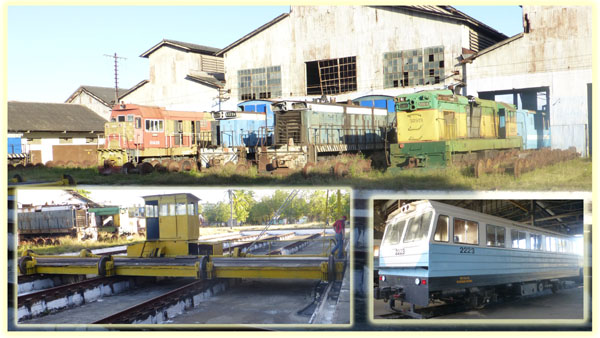 We finished at the central railroad shops at
Moron. This was a major back
shop. But we saw many idle
engines. The man in charge
was quite proud of the place, and they had an actual transfer table.
One of the new Russian rail diesel cars was being readied for service.
The railroad has purchased a number of these things.
We finished at the central railroad shops at
Moron. This was a major back
shop. But we saw many idle
engines. The man in charge
was quite proud of the place, and they had an actual transfer table.
One of the new Russian rail diesel cars was being readied for service.
The railroad has purchased a number of these things.
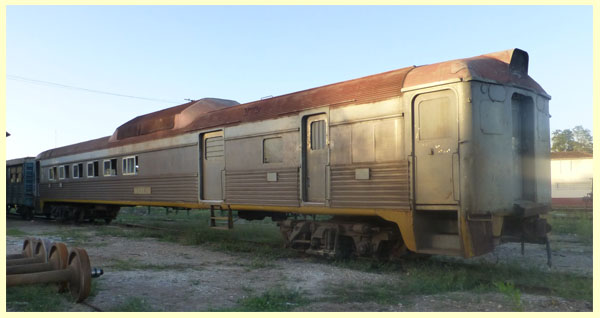 Of note was an older RDC3, which had been stripped of it’s
engines and was now just a trailer.
Speaking of RDC’s, we had bad news about ours.
The gearbox rebuild that was supposed to be completed was taking
longer than anticipated. So
the mechanics can’t get the car in operating shape.
To make matters worse, the railroad has denied a request for a
diesel to pull it. So the
one thing this trip was based on has been scrapped.
This is a major disappointment to all, as there are only a few of
these railcars operating in the world.
But then, this is Cuba. I
would have liked to ride it again, as I think these units are pretty
nifty. But we may have dodged a bullet, since these cars are
aluminum, no windows that open and questionable AC units. As I remember
the morning is OK but by he afternoon it's pretty hot and sauna-like. Our next hotel
was an adventure. The Hotel
Moron was originally built by the Soviets, and has been let to slide.
Yikes. It is bad even
by some of the previous standards.
Off to the usual dinner, but the bar first.
Barb took a shower and there was hot water.
So a plus there.
Of note was an older RDC3, which had been stripped of it’s
engines and was now just a trailer.
Speaking of RDC’s, we had bad news about ours.
The gearbox rebuild that was supposed to be completed was taking
longer than anticipated. So
the mechanics can’t get the car in operating shape.
To make matters worse, the railroad has denied a request for a
diesel to pull it. So the
one thing this trip was based on has been scrapped.
This is a major disappointment to all, as there are only a few of
these railcars operating in the world.
But then, this is Cuba. I
would have liked to ride it again, as I think these units are pretty
nifty. But we may have dodged a bullet, since these cars are
aluminum, no windows that open and questionable AC units. As I remember
the morning is OK but by he afternoon it's pretty hot and sauna-like. Our next hotel
was an adventure. The Hotel
Moron was originally built by the Soviets, and has been let to slide.
Yikes. It is bad even
by some of the previous standards.
Off to the usual dinner, but the bar first.
Barb took a shower and there was hot water.
So a plus there.
March 10
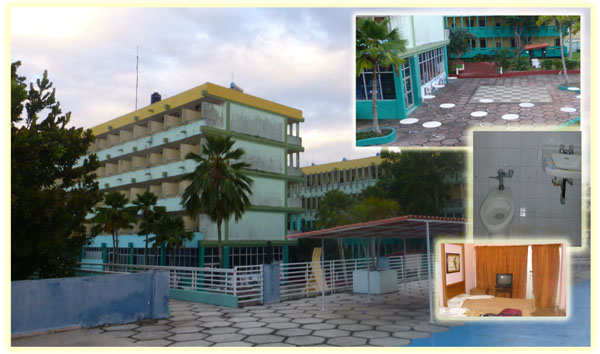 This
hotel has not been kept up very well, and is really rather shabby.
In its heyday, though, I imagine it was quite the place, with a
massive pool, and tons of stuff to do.
I can see the Russians staying here and loving it.
One of our group got a suite on the backside, which was
definitely reserved for the higher-ups.
He had a wet bar (now pulled out,) a sitting room, a massive
bathroom, and huge bedroom. We, however,
were not so lucky. We would see this exact same hotel in
Las Tunas, only it had been kept up.
So instead of handle door pulls, the Las Tunas model had keycard
locks, and the pool was in operation.
It was lovely, and made quite a contrast to our place.
I told one of our guides that she should market it as a chance to
explore an authentic Soviet hotel, built by the Russians, but allowed to
decline a little bit. It’s
all in the marketing.
This
hotel has not been kept up very well, and is really rather shabby.
In its heyday, though, I imagine it was quite the place, with a
massive pool, and tons of stuff to do.
I can see the Russians staying here and loving it.
One of our group got a suite on the backside, which was
definitely reserved for the higher-ups.
He had a wet bar (now pulled out,) a sitting room, a massive
bathroom, and huge bedroom. We, however,
were not so lucky. We would see this exact same hotel in
Las Tunas, only it had been kept up.
So instead of handle door pulls, the Las Tunas model had keycard
locks, and the pool was in operation.
It was lovely, and made quite a contrast to our place.
I told one of our guides that she should market it as a chance to
explore an authentic Soviet hotel, built by the Russians, but allowed to
decline a little bit. It’s
all in the marketing.
We had a surprisingly good breakfast (the food
was good last night as well) and hopped on the bus for a two hour ride
to Camaguey. We checked the
public train schedule for the train buffs, but the only train was at 9
PM, so that was out.
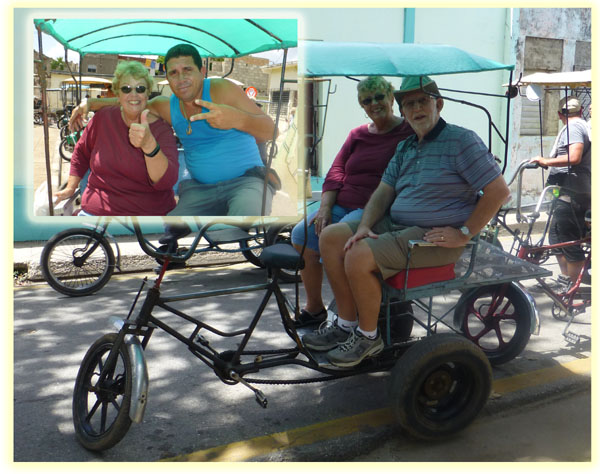 Instead
we did a city tour by BiciTaxi; bicycle taxi.
It was rather fun, and we saw four city squares, and commensurate
churches. It is a lovely city.
Instead
we did a city tour by BiciTaxi; bicycle taxi.
It was rather fun, and we saw four city squares, and commensurate
churches. It is a lovely city.
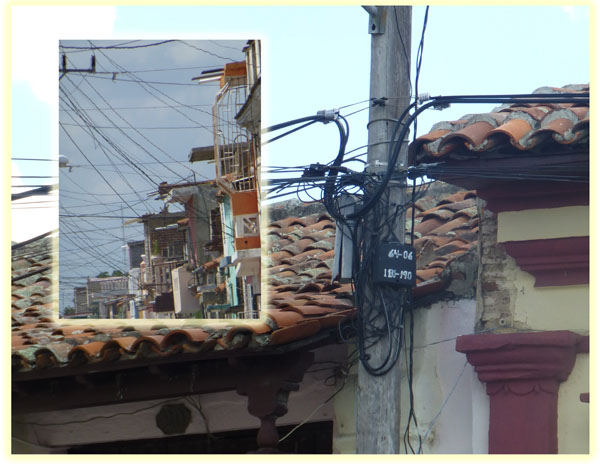
The overhead wiring is a bit more organized than it other parts of the world, but can still be a jumble.
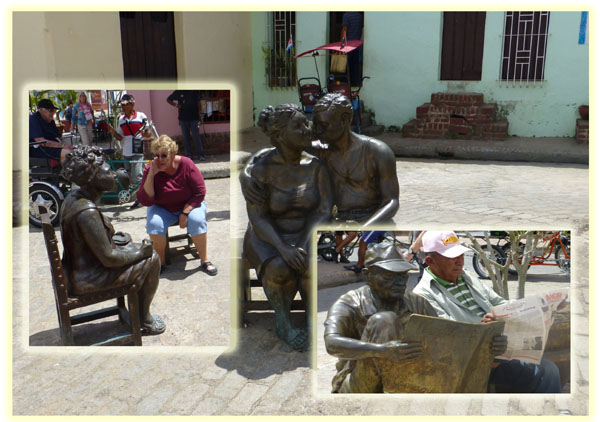 There
are some bronze statues, of three ladies talking (gossiping) that are
pretty well known and Barb had to have her photo taken with one.
Apparently, it is the thing to do.
The city looked pretty prosperous, and there was a great deal of
traffic in narrow streets.
We headed out of Camaguey to Las Tunas for a late lunch.
As the hotel was the better kept up duplicate of last night, we
knew right where the dining room was!
There
are some bronze statues, of three ladies talking (gossiping) that are
pretty well known and Barb had to have her photo taken with one.
Apparently, it is the thing to do.
The city looked pretty prosperous, and there was a great deal of
traffic in narrow streets.
We headed out of Camaguey to Las Tunas for a late lunch.
As the hotel was the better kept up duplicate of last night, we
knew right where the dining room was!
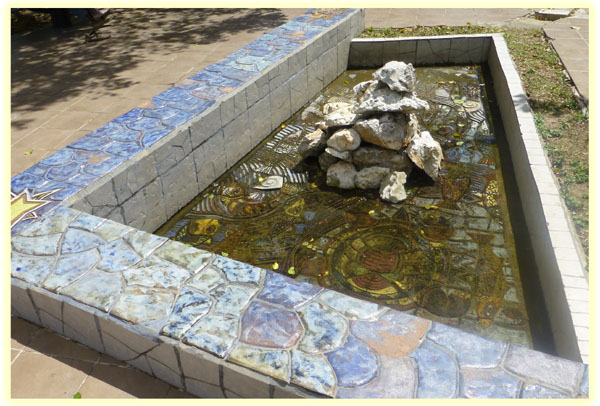
This fountain is somewhat representative of
Cuban infrastructure. It is
beautiful. But it is dirty.
And it is not maintained.
So beneath the grim, lies this gorgeous piece of decoration.
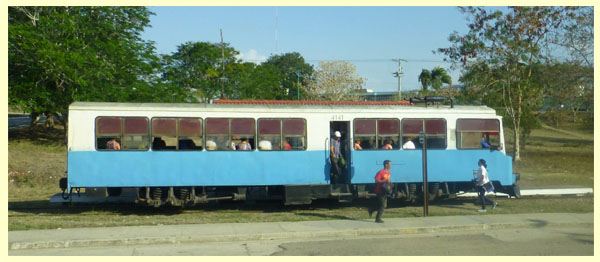 The
Cuban's do still run commuter, or short haul rail, as evidenced by this
East German built rail buses. Here is one in action in Las Tunas.
The
Cuban's do still run commuter, or short haul rail, as evidenced by this
East German built rail buses. Here is one in action in Las Tunas.
Then it was onto the bus to cover the long ride
that was supposed to have been done by the railcar.
We ended up at another all inclusive resort called Playa
Pesquador in Guardalavaca which is located just outside of Holquin.
This place, for a reason unknown to me, has a railroad theme,
with artifacts scattered throughout the complex.
This was pretty nice.
The old adage, the shorter the stay, the better the hotel is
true. We are only here one
night. It is quite large
and very up to date. We
have toilet seats, hot water, lots of room, and quiet surroundings,
right on the beach. This
area has metal mining – nickel, iron, etc.
So it is fairly prosperous.
The nickel ore used for the US Mint comes from here.
Who knew? There was
an after dinner dance show, which, while colorful in costuming, lacked
for variety.
March 11
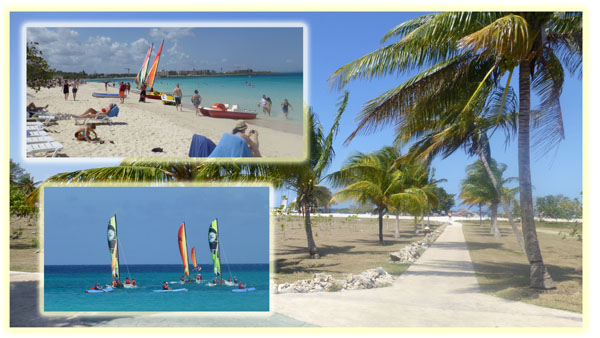 We
opted not to go see the narrow gauge trains today, and instead hung
around the hotel for a relaxing morning.
Wow. I could come
back to this place. We were
told later in the day that the resort is actually owned and run by the
military. Apparently the
bay is of some strategic importance, and if someone wanted to attack,
they would immediately find a resort full of international tourists.
Hum. What are the
political ramifications of that?
I don’t know if there is any truth to the claim, but it makes a
better story than just an place being co-owned by the Italians and the
Castro family.
We
opted not to go see the narrow gauge trains today, and instead hung
around the hotel for a relaxing morning.
Wow. I could come
back to this place. We were
told later in the day that the resort is actually owned and run by the
military. Apparently the
bay is of some strategic importance, and if someone wanted to attack,
they would immediately find a resort full of international tourists.
Hum. What are the
political ramifications of that?
I don’t know if there is any truth to the claim, but it makes a
better story than just an place being co-owned by the Italians and the
Castro family.
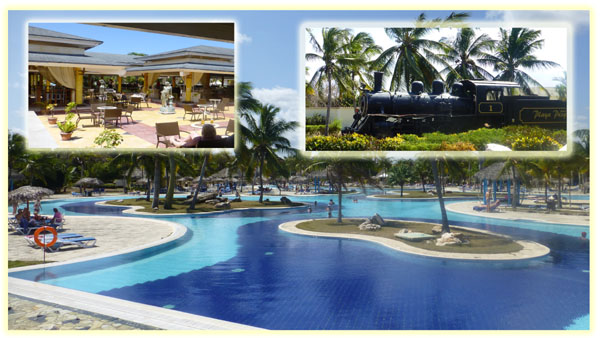
We saw a beautiful beach, azure, clear water, and vast swimming pools. There was plenty of activity, and I’d pick this over Veradero. We definately made the right choice by staying at this resort for the morning. Well needed break.
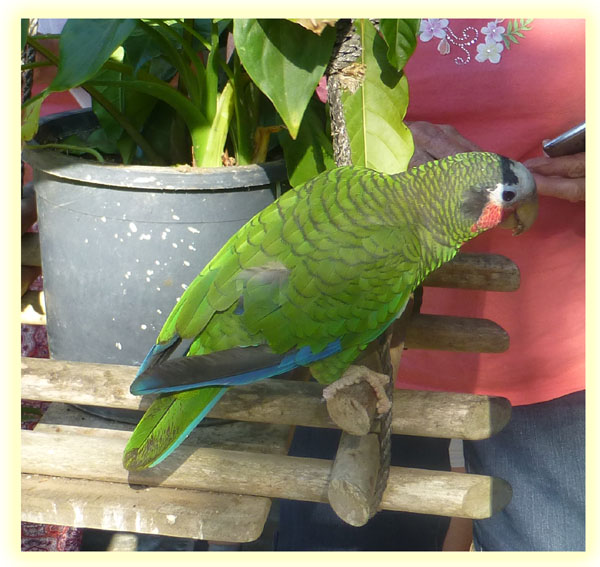
After lunch it was a long, 300 km ride into Guantanamo. We did stop for a bathroom break and were treated to a local family's snack break. There were toilet facilities, good coffee, sweet pineapple and a very tidy little farm. The pig pens were spotless. The family parrot was a hit.
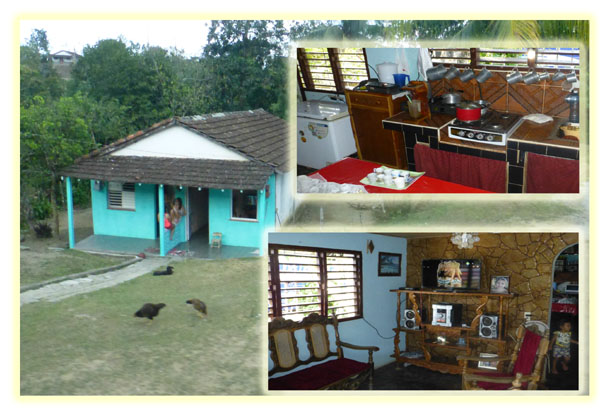 Of
more importance, though, was the opportunity to see the inside of a
local house. It was small,
minimalist, but tidy. The
furnishings were adequate, and there was a flat screen TV.
While the house pictured is not this house, it is the same style, with a
long central hallway, and bedrooms off to one side. Indoor
plumbing though, is not an option. Instead, it is a holding tank
operation.
Of
more importance, though, was the opportunity to see the inside of a
local house. It was small,
minimalist, but tidy. The
furnishings were adequate, and there was a flat screen TV.
While the house pictured is not this house, it is the same style, with a
long central hallway, and bedrooms off to one side. Indoor
plumbing though, is not an option. Instead, it is a holding tank
operation.
We got into Guantanamo after dark. The hotel is a two star, but it is OK. The only anomaly is that due to a severe drought, the water is supposed to be off most of the night. We did not find this to be the case. Dinner was a mystery, but once again, one liquid was included. Tomorrow we again start exploring.
March 12
Here is the word on WiFi in Cuba.
Practically every town square has access.
One had to purchase a card which was an hour for $1.50.
Logging in was easy, but logging out was sometimes difficult.
There did not appear to be any restrictions on what we could
access or see. So if you
were thinking that Cuba is cut off from the rest of the planet (think
North Korea) it is simply not true.
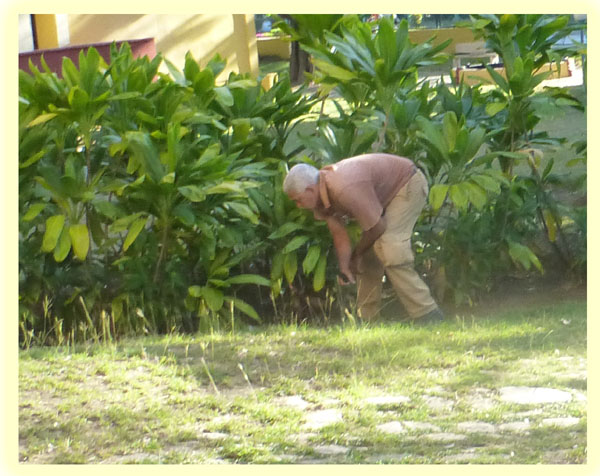 The
Cuban’s definitely knew what was happening in the world.
The hotel WiFi was excellent.
As to the hotel, the water was hot, the AC was cold, and we had a
toilet seat. Life could be
worse. Of course, the water
pressure was a little low, but one can’t have everything.
We were up an hour early due to the daylight savings time change.
None of us expected our phone alarm clocks to roll over, as we
are all on airplane mode.
But they did. So we all were out
and about an hour earlier than usual. Why would you get a lawn
mower, when you have a) goats, or b) a guy with a machete to cut the
grass. Whis is exactly what this man was doing.
The
Cuban’s definitely knew what was happening in the world.
The hotel WiFi was excellent.
As to the hotel, the water was hot, the AC was cold, and we had a
toilet seat. Life could be
worse. Of course, the water
pressure was a little low, but one can’t have everything.
We were up an hour early due to the daylight savings time change.
None of us expected our phone alarm clocks to roll over, as we
are all on airplane mode.
But they did. So we all were out
and about an hour earlier than usual. Why would you get a lawn
mower, when you have a) goats, or b) a guy with a machete to cut the
grass. Whis is exactly what this man was doing.
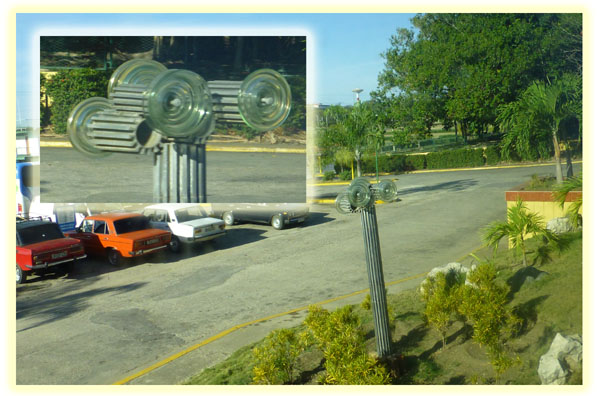
There is artwork to be found in the strangest of places. Note what one can do with old fresnel lenses and some big gears.
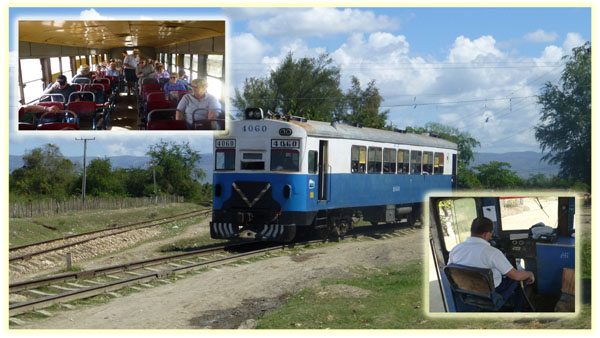 We
headed out from Guantanamo to an old self powered Brill car.
We
headed out from Guantanamo to an old self powered Brill car.
The whole area is restricted, due to the close proximity of the US base. We were on an active line, and thus our ability to stop for runby photos was limited. There would have been a great trestle shot, but we were holding up a local freight operation, so had to move on.
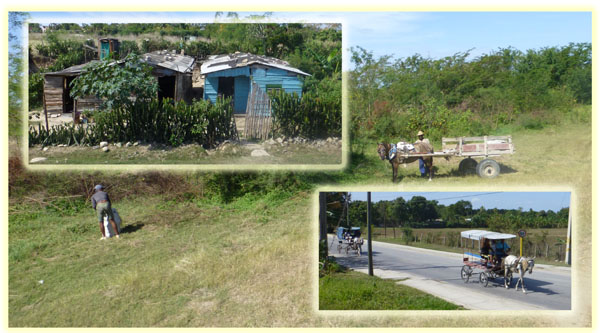
Life along the railroad was the usual small houses, and people on agricultural duty, using horse carts.
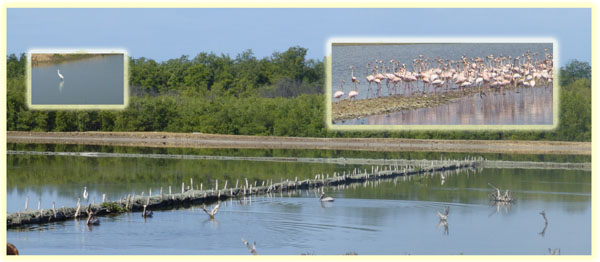 As
we are close to water, we saw plenty of salt flats, which were great
havens for birds. Thre were egrets, pelicans, and some
flamingoes, which the British were thrilled about, as we skirted the
edge of the US base.
As
we are close to water, we saw plenty of salt flats, which were great
havens for birds. Thre were egrets, pelicans, and some
flamingoes, which the British were thrilled about, as we skirted the
edge of the US base.
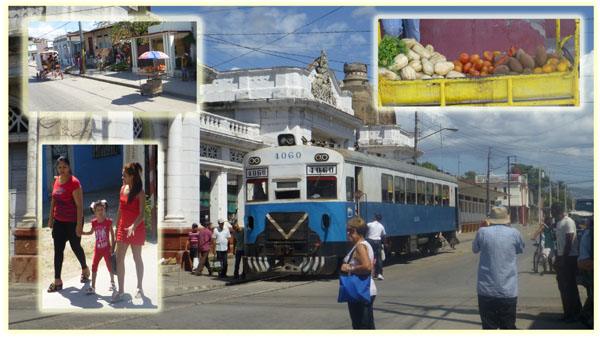
On our way to Caimanera we passed through (I think) Maqueicito. The rail line went right down the main street, so we have a rarity - street running. Yes, we went right through a market on the main street. So there was ample time to experience Sunday morning in a local town.
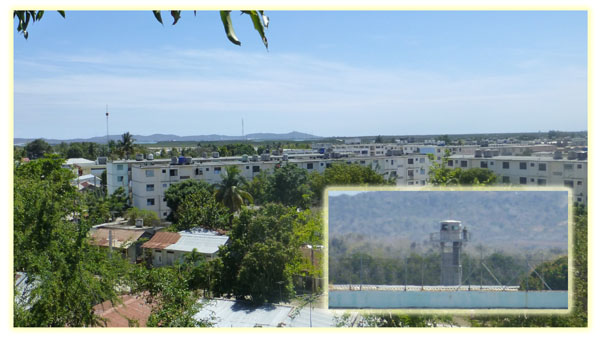 We
stopped for lunch in Caimanero, at a hotel, which was gorgeous.
And the food was outstanding.
I had octopus, and it was delicious.
We were on a little hill, so had a (very) distant view of the US
military base. The photos of the base are fairly low resolution,
as they were shot with my little point and shoot camera, from a great
distance. Walking up to the US base as a US taxpayer and asking
for the tour was not an option.
We
stopped for lunch in Caimanero, at a hotel, which was gorgeous.
And the food was outstanding.
I had octopus, and it was delicious.
We were on a little hill, so had a (very) distant view of the US
military base. The photos of the base are fairly low resolution,
as they were shot with my little point and shoot camera, from a great
distance. Walking up to the US base as a US taxpayer and asking
for the tour was not an option.
Most of the group headed back to the railcar to
ride to Guantanamo, while Barb and I, along with several others, opted
to stay on the bus. We
slept in air conditioned comfort.
The rest of the group, not so much.
Once we all reconvened, headed to another all inclusive resort
about 60 km outside Santiago.
At the time, we thought it unfortunate that we were not
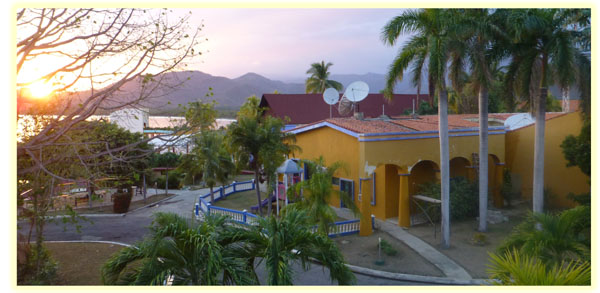 staying
downtown. Later we learned
that we really lucked out, as the downtown hotels are marginal and
noisy. In our case, it was
a matter of hotel overbooking.
The resort, set above a rocky coastline, and stepped into the
hills, was quite lovely. We
could look out and see the southern Caribbean.
So we have seen both sides of the island.
staying
downtown. Later we learned
that we really lucked out, as the downtown hotels are marginal and
noisy. In our case, it was
a matter of hotel overbooking.
The resort, set above a rocky coastline, and stepped into the
hills, was quite lovely. We
could look out and see the southern Caribbean.
So we have seen both sides of the island.
We spent some additional time talking with our two Havantur guides. They were interested in my impressions rom 17 years ago. They agreed with my assessment that life is slowly improving. There are more consumer goods available, and the island has better infrastructure. And of course, everyone has a mobile phone. When asked why Che Guevara more revered than Fidel, the only answer I could ascertain was that Che has been dead longer, and thus elevated to hero status. Fidel is equally loved, but the people are still in mourning.
March 13
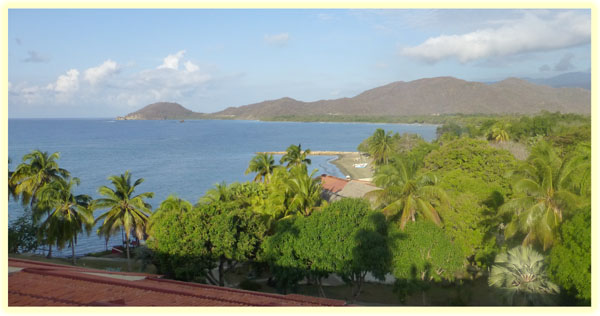 This
is the view that greeted us this morning - the coastline of the southern
shore of Cuba. I have to tell you, these buffets get old
pretty quickly. But when a
resort/hotel has to feed a whole bunch of people, a buffet is a definite
timesaver. On the plus side, the water pressure was great and the
water was hot.
This
is the view that greeted us this morning - the coastline of the southern
shore of Cuba. I have to tell you, these buffets get old
pretty quickly. But when a
resort/hotel has to feed a whole bunch of people, a buffet is a definite
timesaver. On the plus side, the water pressure was great and the
water was hot.
We got to see the country from end to end, and across. The south shore is so much different from the north. And the eastern end of the island is quite different from the rapid urbanization of Havana and agricultural west end.
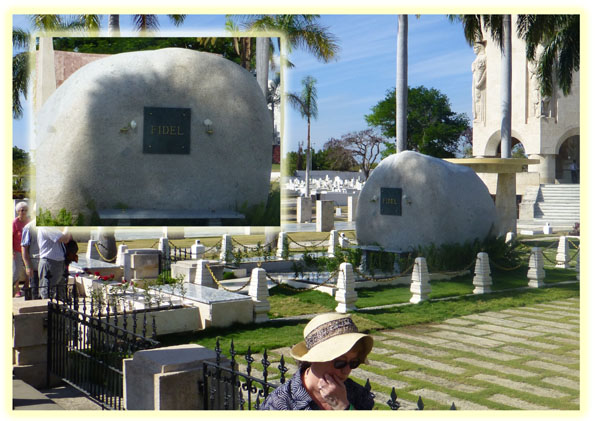 Our
first stop in Santiago was to the main cemetary. Here, we got to
see Jose Marti’s grave, as well as the monument to Fidel.
There are virtually no effigies to Fidel. His desire was that his
ashes be scattered in the fields of his home province. And he
wanted no monuments in his honor. Thus we have this simple stone
rememberance.
Our
first stop in Santiago was to the main cemetary. Here, we got to
see Jose Marti’s grave, as well as the monument to Fidel.
There are virtually no effigies to Fidel. His desire was that his
ashes be scattered in the fields of his home province. And he
wanted no monuments in his honor. Thus we have this simple stone
rememberance.
We were allowed to take photos, and while one of
our tour group was a bit of a jerk, we Americans and British were quiet
and respectful. We observed the
changing of the guard (Low Rez Video Clip
![]() )
and just wandered the cemetary of national heros.
)
and just wandered the cemetary of national heros.
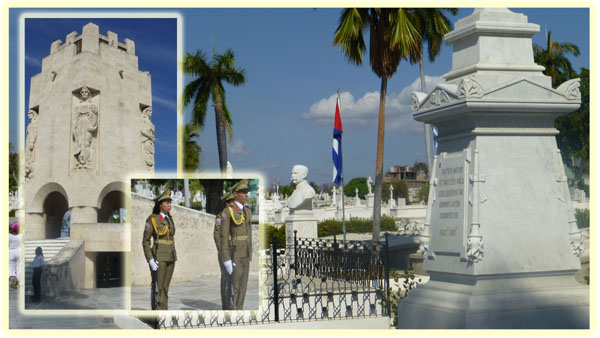 I
truly think that Fidel did a great deal of good for the nation.
It is, after all, a socialist experiment, and should be closely
studied and evaluated.
Perhaps the future will prove that he was way off base, but for the
moment, the population has opportunity, increased consumer options, and
good health care. There is
a steady (if not a good quantity) of food, and reasonable cost of
living. The electrical
system is robust, and while it looks like there is a lot of litter, it
ain’t India. On the other
hand, it isn’t Singapore.
Are there problems?
Sure. The economy is state
managed, as are private sales of commodities.
As the model seems to the be Chinese approach, entrepreneurship
has loosened up, so time will tell how it all works out.
Until today, we saw very few people begging.
Santiago was a different story, with a rather comparatively large
stream of people with their hands out, and people just hanging around.
Santiago may be the City of Hero’s, but I would live elsewhere.
Unless the parts I did not see are much nicer.
I
truly think that Fidel did a great deal of good for the nation.
It is, after all, a socialist experiment, and should be closely
studied and evaluated.
Perhaps the future will prove that he was way off base, but for the
moment, the population has opportunity, increased consumer options, and
good health care. There is
a steady (if not a good quantity) of food, and reasonable cost of
living. The electrical
system is robust, and while it looks like there is a lot of litter, it
ain’t India. On the other
hand, it isn’t Singapore.
Are there problems?
Sure. The economy is state
managed, as are private sales of commodities.
As the model seems to the be Chinese approach, entrepreneurship
has loosened up, so time will tell how it all works out.
Until today, we saw very few people begging.
Santiago was a different story, with a rather comparatively large
stream of people with their hands out, and people just hanging around.
Santiago may be the City of Hero’s, but I would live elsewhere.
Unless the parts I did not see are much nicer.
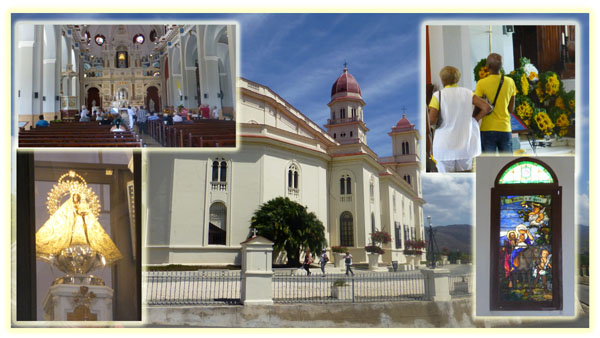 From
the memorial, we went to El Cobia, or the Church of the Black Madonna.
You could purchase flowers to leave at the altar, and make a
wish, which is exactly what we did.
From
the memorial, we went to El Cobia, or the Church of the Black Madonna.
You could purchase flowers to leave at the altar, and make a
wish, which is exactly what we did.
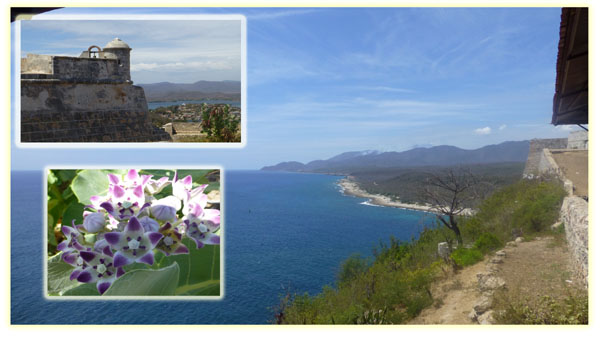 Then
it was to the El Morro Restaurant for a long lunch overlooking the
Caribbean. Lunch was good,
but whoever runs this deal has got to be paying some serious “mordita”
to Havanatur. The tour
buses were all lined up, and it was a money making industrialized lunch
operation. The food was
adequate; pulled pork (surprise!) and fish puffs, followed by ice cream.
Then
it was to the El Morro Restaurant for a long lunch overlooking the
Caribbean. Lunch was good,
but whoever runs this deal has got to be paying some serious “mordita”
to Havanatur. The tour
buses were all lined up, and it was a money making industrialized lunch
operation. The food was
adequate; pulled pork (surprise!) and fish puffs, followed by ice cream.
We wandered a bit, and had ample "free time" to shop for additional souveniers.
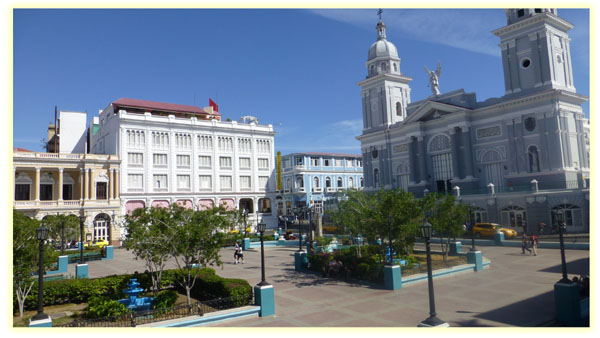 We
finally did get out of the restaurant and into Santiago for a city tour,
which thankfully got cut short.
And it was hot, HoT, HOT.
The four of us went to a museum, which was a display of old rooms
and a household, which was quite interesting.
And then we headed to the nearest hotel bar for frigo bebidas
(cold drinks.) And we
discovered the rest of the group was already there.
We
finally did get out of the restaurant and into Santiago for a city tour,
which thankfully got cut short.
And it was hot, HoT, HOT.
The four of us went to a museum, which was a display of old rooms
and a household, which was quite interesting.
And then we headed to the nearest hotel bar for frigo bebidas
(cold drinks.) And we
discovered the rest of the group was already there.
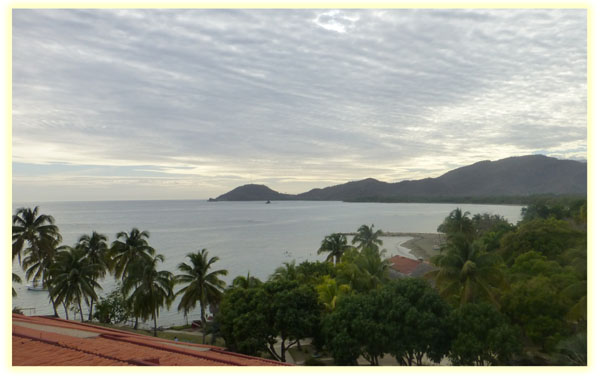 Soon
it was back to the hotel.
Tomorrow is our last full day on this end of the island.
Just walking around, I met a guy from Toronto.
He has been to Cuba 70 times for vacation.
And he stays at this place, or affiliated Brisas properties or
Guadalavaca. He says that
the staff treats you like family, and that this is the safest place
around (Cuba, that is). He
said we were lucky to get this place instead of staying in Santiago, as
even the best hotel is a former Russian cubicle box.
The evening entertainment was an aquatic show, which was fun.
Once again we talked one on one with our Havanatur guides. Both
are delightful and personable young women.
Soon
it was back to the hotel.
Tomorrow is our last full day on this end of the island.
Just walking around, I met a guy from Toronto.
He has been to Cuba 70 times for vacation.
And he stays at this place, or affiliated Brisas properties or
Guadalavaca. He says that
the staff treats you like family, and that this is the safest place
around (Cuba, that is). He
said we were lucky to get this place instead of staying in Santiago, as
even the best hotel is a former Russian cubicle box.
The evening entertainment was an aquatic show, which was fun.
Once again we talked one on one with our Havanatur guides. Both
are delightful and personable young women.
March 14
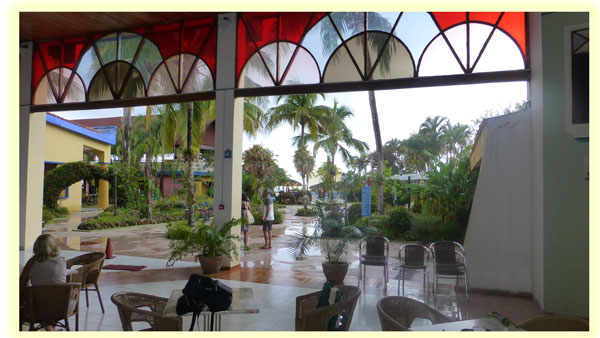 The
resort is still gorgeous, even in the morning light.
We had three power outages last night.
It must have been the big rainstorm that I somehow slept through.
The
resort is still gorgeous, even in the morning light.
We had three power outages last night.
It must have been the big rainstorm that I somehow slept through.
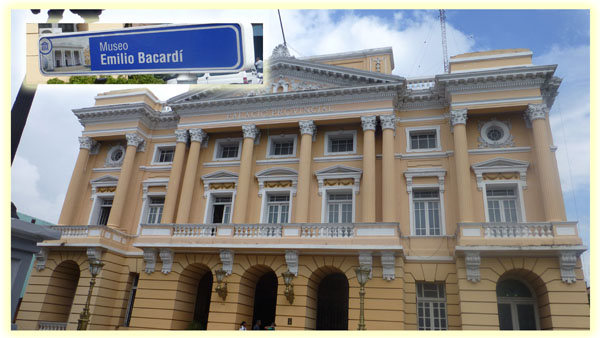 Today
we had more “free time” in Santiago.
The weather was extremely hot and humid, which I don’t do well.
We did the Bacardi Museum, which had art, historical artifacts,
and pre-ethnology remains, such as mummified remains from people who
were here a long, long time ago.
There were no English cards or descriptions.
Today
we had more “free time” in Santiago.
The weather was extremely hot and humid, which I don’t do well.
We did the Bacardi Museum, which had art, historical artifacts,
and pre-ethnology remains, such as mummified remains from people who
were here a long, long time ago.
There were no English cards or descriptions.
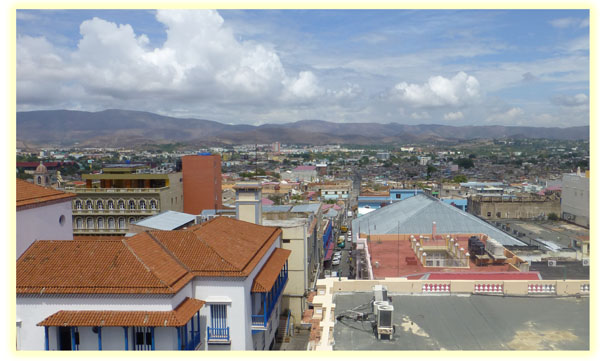 Lunch
was on the rooftop of the Grand Hotel, which is a lovely place, shady
with a breeze.
From here, we could see over the rooftops of the town, and admire the
distant countryside.
Lunch
was on the rooftop of the Grand Hotel, which is a lovely place, shady
with a breeze.
From here, we could see over the rooftops of the town, and admire the
distant countryside.
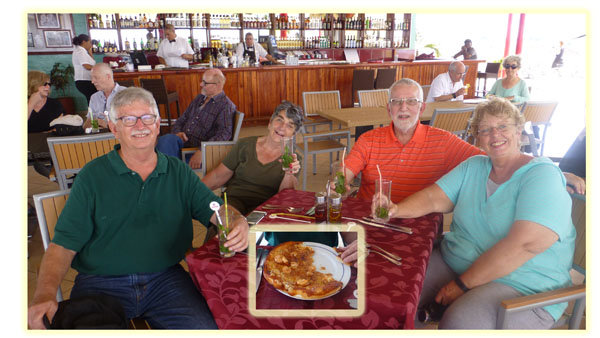 Here
we are, the four - what, Musketeers? Horsemen? This is my
brother John, a friend from his twon, Noel, Dave (me) and Barb. We
are sharing (what else) mojitos, and a pizza, which is the insert.
The flavor was pineapple, onion and tuna. Sounds horrible, tasted
yummy.
Here
we are, the four - what, Musketeers? Horsemen? This is my
brother John, a friend from his twon, Noel, Dave (me) and Barb. We
are sharing (what else) mojitos, and a pizza, which is the insert.
The flavor was pineapple, onion and tuna. Sounds horrible, tasted
yummy.
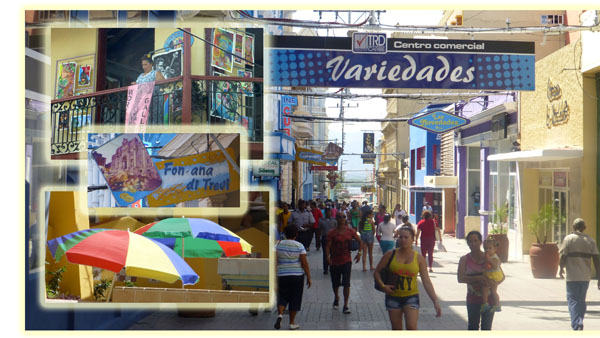 Many
of the Cuban towns we visited has pedestrian malls or streets.
Santiago was no exception, with art galleries, restaurants, bars and al
fresco dining opportunities.
Many
of the Cuban towns we visited has pedestrian malls or streets.
Santiago was no exception, with art galleries, restaurants, bars and al
fresco dining opportunities.
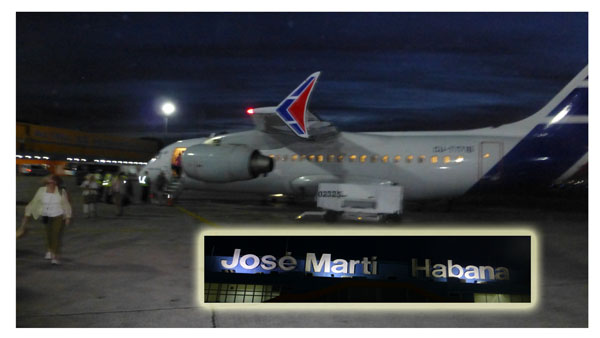 Finally
we were out of Santiago, to the airport, and hopped an Antonov 158 which
was a half hour late. Does
anything run on time?
Finally
we were out of Santiago, to the airport, and hopped an Antonov 158 which
was a half hour late. Does
anything run on time?
Finally we got into Havana, and went back to the
Plaza Hotel. Our room is
right next to the previous one.
At least it has a queen bed, but the toilet still doesn’t flush
well. Hot water remains to
be seen. Due to the late hour, dinner
was half a sandwich in the bar.
March 15
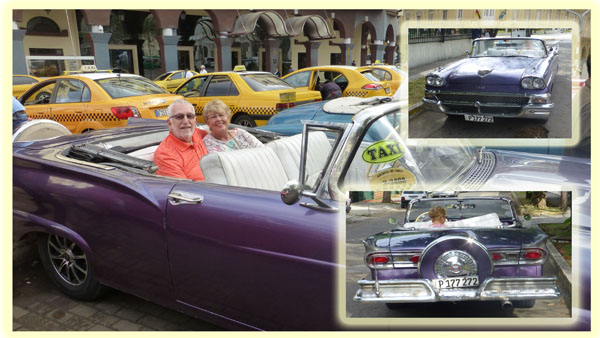 We
had hot water. Yippee!
So it was a nice shower after a somewhat sleepless night.
Today, the first thing we did was to complete a mission that I
regretted not doing 17 years ago.
What was that? Barb
and I took a purple ’58 Ford Fairlane 500 up to Embassy Row.
We
had hot water. Yippee!
So it was a nice shower after a somewhat sleepless night.
Today, the first thing we did was to complete a mission that I
regretted not doing 17 years ago.
What was that? Barb
and I took a purple ’58 Ford Fairlane 500 up to Embassy Row.
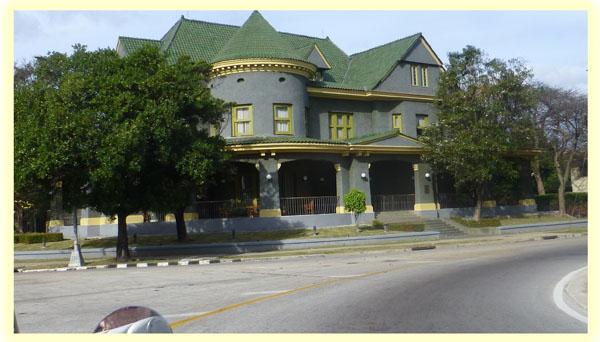 We
passed the Castro House, or so we were
told. Truthfully, I can't be certain is this was once of his homes
or not. Reasearch simply lists the residence as Casa Verde, with
no additional imformational tags. I was twice told that this was
once of his homes, once in 2000, and now in 2017. Further digging
will give results that it is a private hotel, which I am personally more
iunclined to believe.
We
passed the Castro House, or so we were
told. Truthfully, I can't be certain is this was once of his homes
or not. Reasearch simply lists the residence as Casa Verde, with
no additional imformational tags. I was twice told that this was
once of his homes, once in 2000, and now in 2017. Further digging
will give results that it is a private hotel, which I am personally more
iunclined to believe.
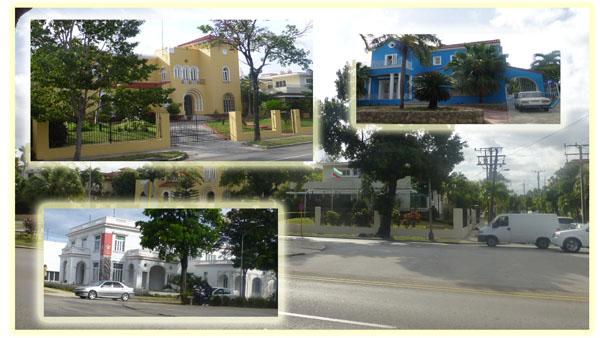 Embassy
Row, the name given to Fifth Avenue, is located in Miramar, a section of
Havana. Here on finds stately old homes and mansions, most of
which have now been turned into embassy and staff lodgings.
Embassy
Row, the name given to Fifth Avenue, is located in Miramar, a section of
Havana. Here on finds stately old homes and mansions, most of
which have now been turned into embassy and staff lodgings.
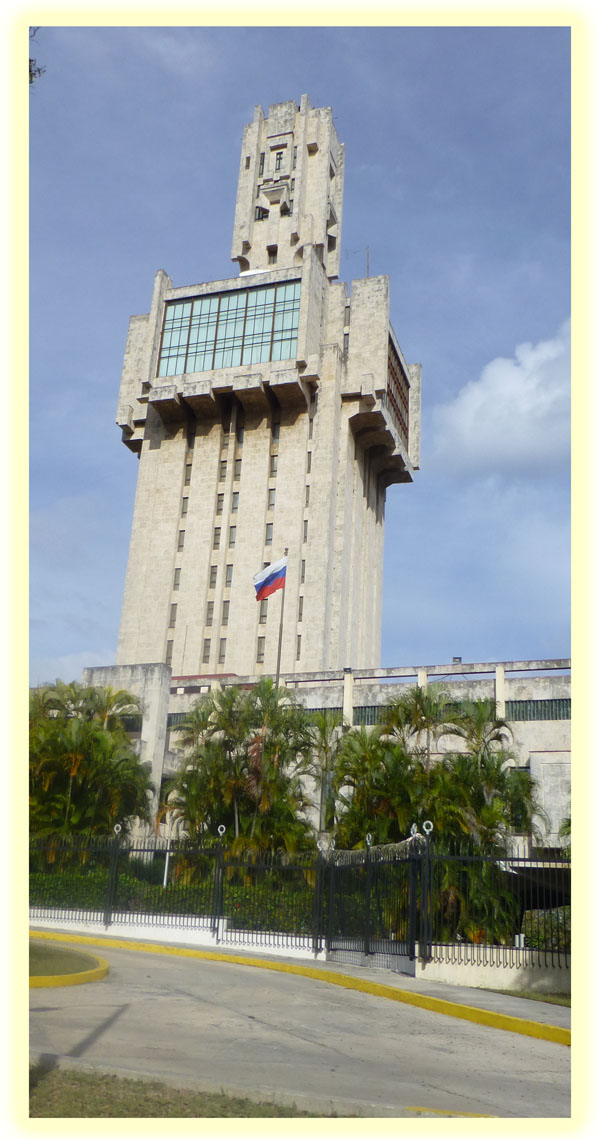 In
this quiet and beautiful neighborhood lies this monstrosity – a salute
to Soviet architecture at its best.
Or worst. This Soviet
Embassy is so out of place it is unreal.
In
this quiet and beautiful neighborhood lies this monstrosity – a salute
to Soviet architecture at its best.
Or worst. This Soviet
Embassy is so out of place it is unreal.
So one of my missions on my return visit was accomplished. I just HAD to get a photo of this place.
And riding in that car, with the music blasting – what fun, fun, fun.
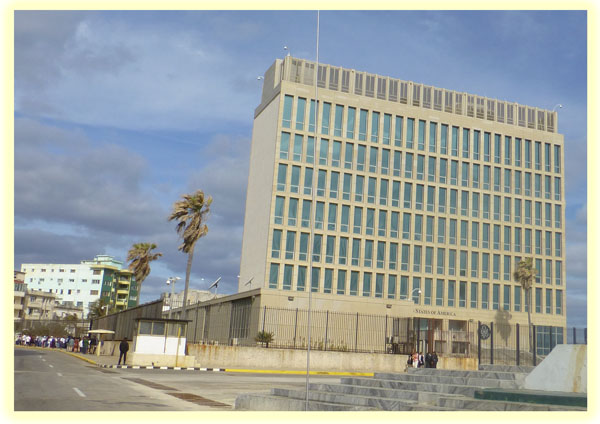 On
the way back to central Havana, we passed the American Embassy. If
you look closely to the left of the picture frame, you can see a long
line of people who were waiting to get visas to visit the USA.
There were additional lines in a large parking lot across the street.
On
the way back to central Havana, we passed the American Embassy. If
you look closely to the left of the picture frame, you can see a long
line of people who were waiting to get visas to visit the USA.
There were additional lines in a large parking lot across the street.
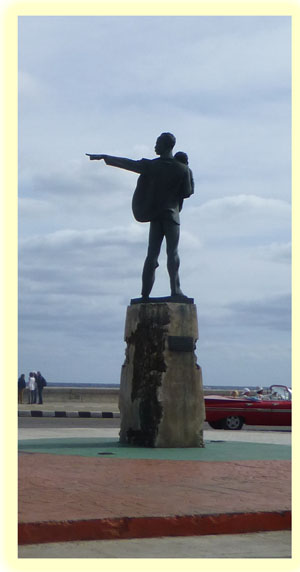 We
also passed the "Elian Gonzalez" statue. This is actually a
stature of Jose' Marti holding a small child. When all the hoopla
about Elian Gonzalez was going on back in 2000, the Cubans wryly
referred to this statue as Marti holding Elian and saying, "Elian.
Florida is that way!"
We
also passed the "Elian Gonzalez" statue. This is actually a
stature of Jose' Marti holding a small child. When all the hoopla
about Elian Gonzalez was going on back in 2000, the Cubans wryly
referred to this statue as Marti holding Elian and saying, "Elian.
Florida is that way!"
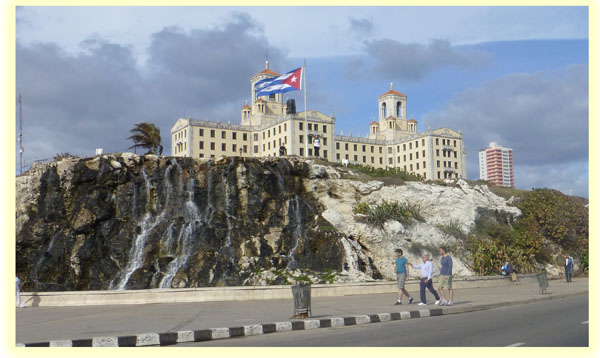
We also passed by the National Hotel, which was THE hotel in Havana. It has been restored, and is apparently still quite a lovely place to stay. I'll bet they have toilet seats!
Once we returned to the central square, we ventured off to the Belle Arts Museum, just a few blocks from the hotel, and there was quite a lovely art collection and items from ancient cultures around the world. The building itself was quite a gem. We had a roof top lunch at a neighboring hotel.
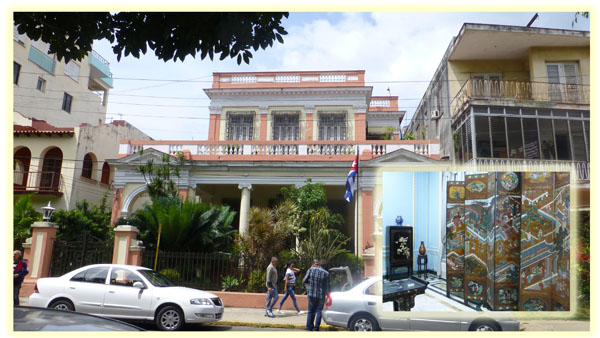 The
piece de resistance of the afternoon – a visit to the National Museum of
Decorative Arts. It was
located some ways away from the downtown, actually a few blocks from the
National Hotel. This was
the home of Maria Luisa Gomez Mena, Countess of Revilla of Camargo.
And each room was jaw droppingly spectacular.
The fan collection alone was just amazing.
The furnishings were from the 1920/30’s, and all intact, as were
the wall decorations, inlaid materials, and painting.
The fan collection alone was simply stunning. It is off the
beaten track, but OMG, what a place.
If you ever get here, it is worth a stop.
I apologize for not having more photos, but was unwilling to pay the
photo license fee.
The
piece de resistance of the afternoon – a visit to the National Museum of
Decorative Arts. It was
located some ways away from the downtown, actually a few blocks from the
National Hotel. This was
the home of Maria Luisa Gomez Mena, Countess of Revilla of Camargo.
And each room was jaw droppingly spectacular.
The fan collection alone was just amazing.
The furnishings were from the 1920/30’s, and all intact, as were
the wall decorations, inlaid materials, and painting.
The fan collection alone was simply stunning. It is off the
beaten track, but OMG, what a place.
If you ever get here, it is worth a stop.
I apologize for not having more photos, but was unwilling to pay the
photo license fee.
While our ride to the museum was in a new, Geeley cab, which was cramped, our ride back was in a late '30's Dodge sedan, which was as roomy as all get out.
The day started to wind down as we headed off to
meet our new British friends for a drink.
Dinner is at our determination.
The Plaza really has done some remodeling.
The lobby area is lovely, and the restaurant has had some work
done. But remodeling the
rooms is going to take more than a fresh coat of paint.
Start with new plumbing, new fixtures, and electrical.
The bathrooms need proper shower heads, toilets that are up today
and operable, new sinks, new sink fittings, and simple things like
toilet paper holders, soap dispensers/holders, towel racks.
The rooms need lamps, new mattresses, chairs, and doors that
actually open and close, along with new latches.
The AC is up to date, as are the curtains and bedspreads.
But the areas around the AC inlets need to be sealed, with better
windows and soundproofing.
Unless this place is upgraded, I don’t think I will return.
If you want a recommendation, I’d pick a place close by, and
newer. It may cost more,
but in the long run, you will have a better room, nicer clientele (not
youth groups) and be much more comfortable.
Tomorrow we go home.
I am repacked. This was
another amazing adventure trip, with highs and subsequent lows.
We met wonderful people, saw more than the standard tour groups
see, and really had an overall enjoyable adventure.
But we are glad to be going home.
March 16
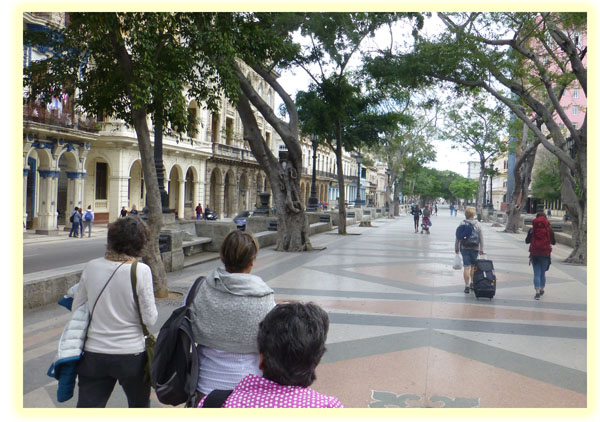 This
was our last day in Cuba, as we leave for the airport at Noon.
It was a cool morning, at only 70 degrees, which is a pleasant
change from the heat and humidity of Santiago.
We spent some time just walking around, first the wide, central
walking area in the boulevard Paseo del Prado by the hotel.
We basically walked out to the ocean, and back.
This
was our last day in Cuba, as we leave for the airport at Noon.
It was a cool morning, at only 70 degrees, which is a pleasant
change from the heat and humidity of Santiago.
We spent some time just walking around, first the wide, central
walking area in the boulevard Paseo del Prado by the hotel.
We basically walked out to the ocean, and back.
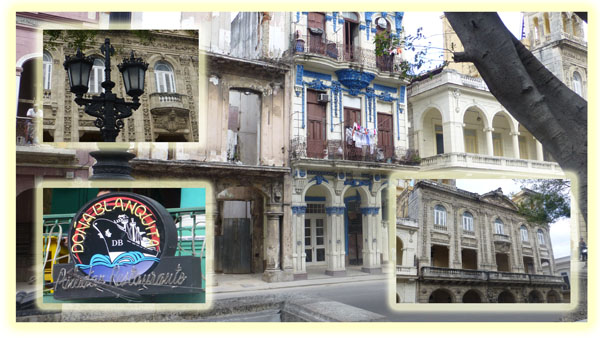 Note
that some of the buildings have been beautifully restored. But
they will be located right next to a place that is gutted. I'm
sure this was once a stunning city. Time and climate have taken
their toll. It could once again be a gorgeous gem, but that would
require a huge influx of capitol. I don't see that happening any
time soon.
Note
that some of the buildings have been beautifully restored. But
they will be located right next to a place that is gutted. I'm
sure this was once a stunning city. Time and climate have taken
their toll. It could once again be a gorgeous gem, but that would
require a huge influx of capitol. I don't see that happening any
time soon.
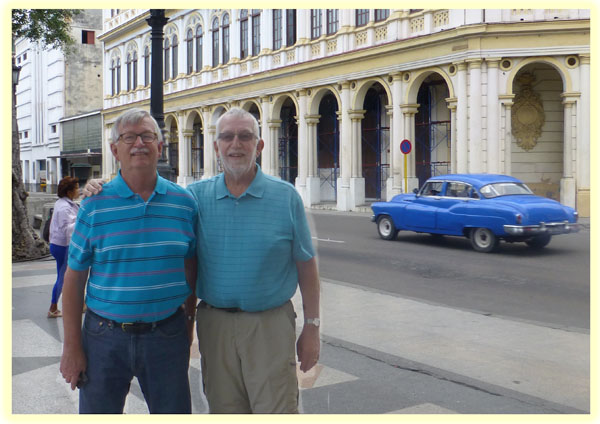
Here we are again, two guys from Iowa who have traveled the world. And now we have visited the time machine that is modern day Cuba.
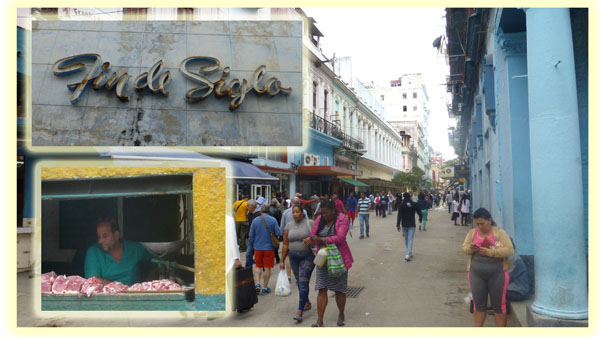 We
continued walking down a pedestrian mall nearby.
In its day, this must have been a wonderful retail area.
Now, not so much, as the big department stores are gone, given
over to little retail stalls.
There were the usual spate of shuttered fronts, and other places
trying to get by on tourist dollars.
The contrast between the fairly well restored buildings and the
stuff that has fallen to wrack and ruin is remarkable.
So we will be out of here at Noon, and into the madhouse that is
Jose Marti Airport.
We
continued walking down a pedestrian mall nearby.
In its day, this must have been a wonderful retail area.
Now, not so much, as the big department stores are gone, given
over to little retail stalls.
There were the usual spate of shuttered fronts, and other places
trying to get by on tourist dollars.
The contrast between the fairly well restored buildings and the
stuff that has fallen to wrack and ruin is remarkable.
So we will be out of here at Noon, and into the madhouse that is
Jose Marti Airport.
Once at Jose Marti, there was a lot of standing in line, be it waiting to get boarding passes, pass emigration, or exchange our remaining money into dollars. We lucked out on the latter, as we met a mother and daughter from Philadelphia. They did not realize that the window they were standing at was for outgoing only and they needed cash for a cab ride into town. So we cut them a favorable deal on CUC’s for dollars, and we were all happy. The waiting area involved several gate changes, and the usual confusion at boarding. But we got back to the USA, through customs and immigration, and nachos in the Miami airport; the best nachos ever. Absence does make the heart grow fonder!
Cuba has been a wonderful experience.
As with all of the Trains Unlimited trips, you get off the
tourist route, and get to see more of the local culture and life. This
is both good and bad, as hotels are not up to great standards, and the
streets and roads are not as glitzy as tourists would like.
The thing is more authentic in my opinion.
Barb is quite glad she came, although she says that she will
think twice about “wanting to see a place before it changes.”
All it all, it was quite an adventure.
Old Cars
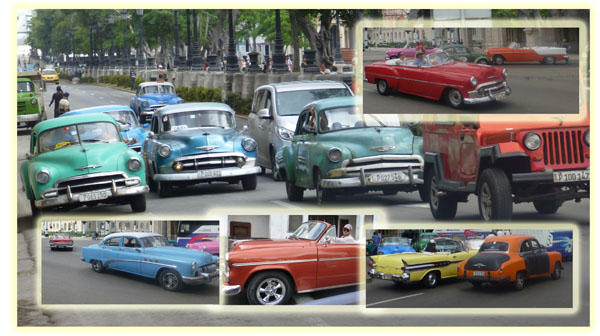 Everyone
that goes to Cuba talks about the old cars.
And I shall be just like the rest of the gearheads.
First off, I took a LOT of old car photos - way to many to post here.
I shall attempt to weed them out and just give you a taste for what is
on the streets in everyday use.
Everyone
that goes to Cuba talks about the old cars.
And I shall be just like the rest of the gearheads.
First off, I took a LOT of old car photos - way to many to post here.
I shall attempt to weed them out and just give you a taste for what is
on the streets in everyday use.
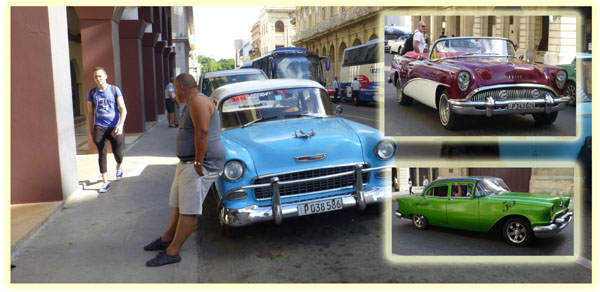
The place is a mecca for old car enthusiasts. But, and yes, there is a but here, most of them are not original. You can find a few original American vehicles, and the owners are proud to show off the clean and polished engines.
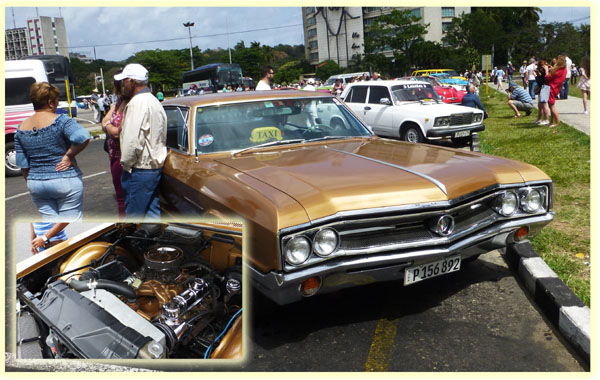
As an example, check out this 1965 Buick Wildcat. It isn’t the original color, but the vehicle certainly is an eye catcher. This one even has the original engine. I think this was the most recent "Detroit" car that I saw.
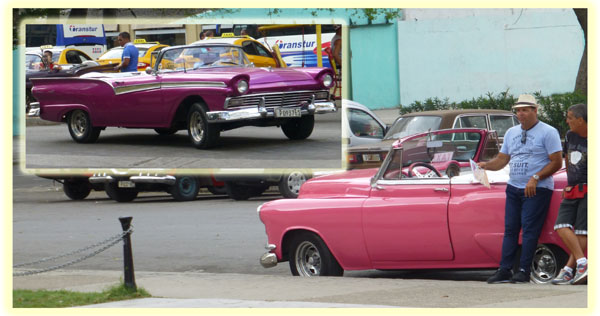 Most
tended to be from the 1940's through the early 60's. The paint
schemes run all over the map, with some cars being done in "factory"
colors, while others are more eye catching in purple and pink.
Most
tended to be from the 1940's through the early 60's. The paint
schemes run all over the map, with some cars being done in "factory"
colors, while others are more eye catching in purple and pink.
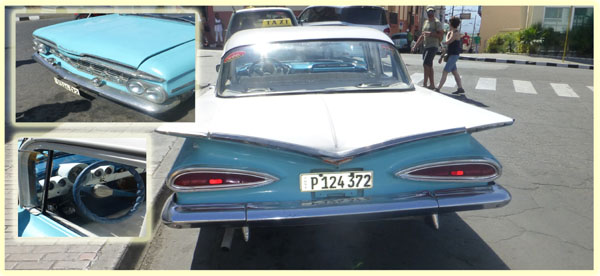 I
only saw a few of my favorite, which is the ’59 Cat’s Eye Chevrolet.
There truly is something for everyone here.
I’m a little hazy on recognition for Chrysler products, but an
enthusiast will easily recognize the makes and models.
Most of the cars have small diesels and drivetrains pulled from
elsewhere. The American
vintage range from pre world war 2 through the late 1950s although you
can find an occasional ride going into the early '60s.
I don’t think I saw anything beyond ’65.
If the car has a “P” plate, it is personally owned. The
owner can get it mechanically certified to be used as a taxi.
As for license plates, T = Tourist (Rental), F = Army, K=
Foreign, B = Government, M = Military, D = Diplomat.
I
only saw a few of my favorite, which is the ’59 Cat’s Eye Chevrolet.
There truly is something for everyone here.
I’m a little hazy on recognition for Chrysler products, but an
enthusiast will easily recognize the makes and models.
Most of the cars have small diesels and drivetrains pulled from
elsewhere. The American
vintage range from pre world war 2 through the late 1950s although you
can find an occasional ride going into the early '60s.
I don’t think I saw anything beyond ’65.
If the car has a “P” plate, it is personally owned. The
owner can get it mechanically certified to be used as a taxi.
As for license plates, T = Tourist (Rental), F = Army, K=
Foreign, B = Government, M = Military, D = Diplomat.
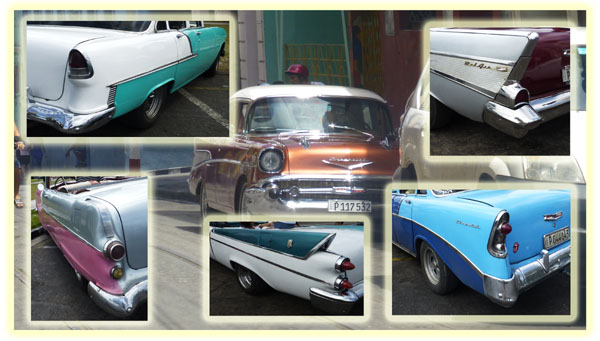 So
the ’58 Ford we rode in was a family car, with a Russian diesel
powertrain, and used to make extra money.
There are some beautiful vehicles, and the owners take great
pride in these cars, as they recognize the value.
So
the ’58 Ford we rode in was a family car, with a Russian diesel
powertrain, and used to make extra money.
There are some beautiful vehicles, and the owners take great
pride in these cars, as they recognize the value.
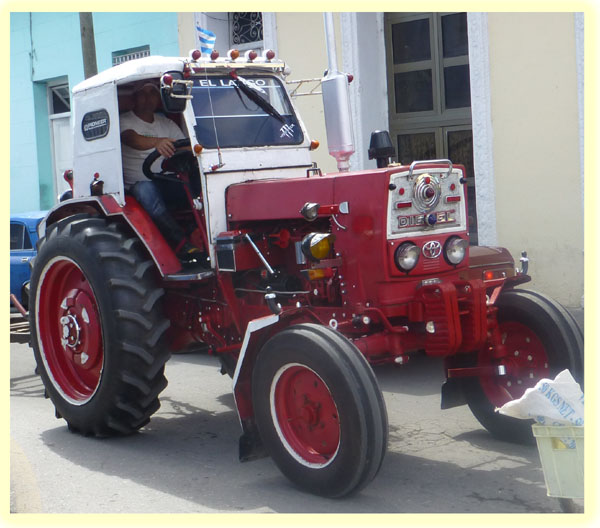
Plus these guys love their vehicles. Note the fancy decorations on a regular tractor.
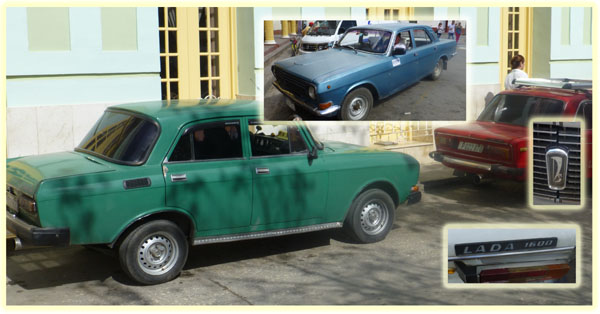
Otherwise, there is the usual run of Lada 1600’s, a few Moskovich’s, and an occasional Volga. There are many new Geeley autos on the road as well as a few VW’s.
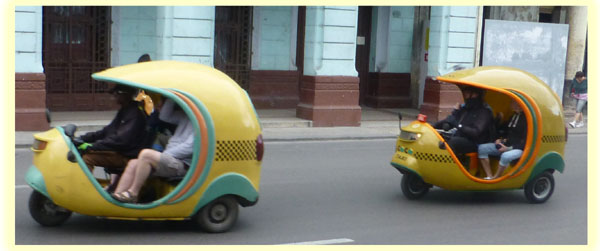
There are also motorbikes and tuk-tuks.
And we saw something that I had not seen - electric motorcycles.
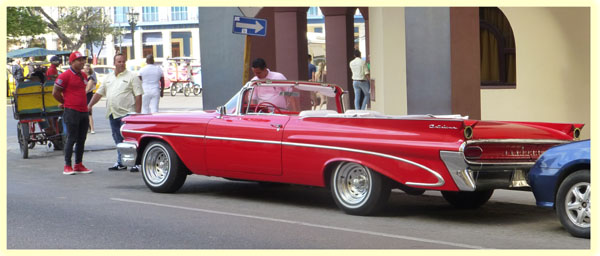
Check out this amazing '59 Pontiac. it is a beauty!
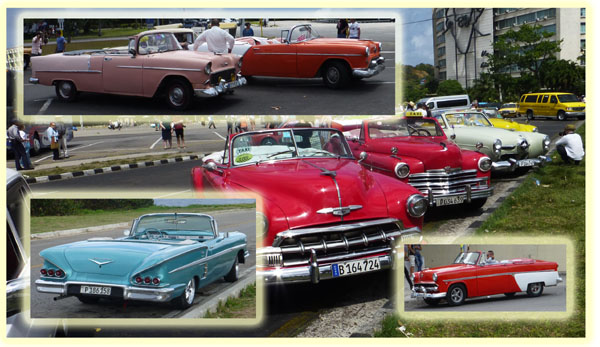
Over the two weeks, I saw perhaps less than five
new, high end cars such as Mercedes.
It is the old cars of the 1950s that my age group loves.
Seeing all this old Detroit iron is really quite a thrill.
